
Eastern Taipei After Dark Panoramic City Rides
An Eye-Opening Opera Experience
36 No . Summer 202 4
PICK UP POINTS
台北市政府觀光傳播局
Department of Information and Tourism, Taipei City Government
4 F, 1 , City Hall Rd., Taipei City (02) 2720-8889/1999 ext. 7564
台灣桃園國際航空站一
Tourist Service Center at Arrival Lobby, Taiwan Taoyuan International Airport Terminal 1
15 , Hangzhan S. Rd., Taoyuan City (03) 398-2194
台灣桃園國際航空站二
Tourist Service Center at Arrival Lobby, Taiwan Taoyuan International Airport Terminal 2
9 , Hangzhan S. Rd., Taoyuan City (03) 398-3341
松山車站
Songshan Station
11 , Songshan Rd., Taipei City (02) 2767-3819
南港車站
Nangang Station
313, Sec. 1, Nangang Rd., Taipei City (02) 2783-8645
美國在台協會
American Institute in Taiwan
100 , Jinhu Rd., Taipei City (02) 2162-2000
遠企購物中心
Taipei Metro the Mall
203 , Sec. 2 , Dunhua S. Rd., Taipei City (02) 2378-6666 ext. 6666
國語日報語文中心
Mandarin Daily News (Language Center)
2F, 2, Fuzhou St., Taipei City (02) 2341-8821
台北松山機場
Taipei Songshan Airport
340 - 9 , Dunhua N. Rd., Taipei City (02) 8770-3430
榕錦時光生活園區
Rongjin Gorgeous Time 167, Jinhua St., Taipei City (02) 2321-8896
台北美國學校
Taipei American School
800 , Sec. 6 , Zhongshan N. Rd., Taipei City (02) 2873-9900
國立國父紀念館
National Dr. Sun Yat-sen Memorial Hall
505, Sec. 4, Ren’ai Rd., Taipei City (02) 2758-8008
國立中正紀念堂
National Chiang Kai-shek Memorial Hall 21 , Zhongshan S. Rd., Taipei City (02) 2343-1100
台北當代藝術館
Museum of Contemporary Art (MoCA), Taipei 39 , Changan W. Rd., Taipei City (02) 2552-3721
市長官邸藝文沙龍
Mayor’s Residence Arts Salon
46 , Xuzhou Rd., Taipei City (02) 2396-8198
寶藏巖國際藝術村
Treasure Hill Artist Village
2 , Aly. 14, Ln. 230, Sec. 3, Tingzhou Rd., Taipei City (02) 2364-5313
新富町文化市場
U-mkt (Xinfu Market)
70, Sansui St., Taipei City (02) 2308-1092
交通部觀光署旅遊服務中心
Travel Service Center, Tourism Administration, MOTC
240 , Dunhua N. Rd., Taipei City (02) 2717-3737
台北之家
Taipei Film House
18 , Sec. 2 , Zhongshan N. Rd., Taipei City (02) 2511-7786
台北市政府秘書處市民服務組 Information and Assistance Division, Secretariat, Taipei City Government 1 , City Hall Rd., Taipei City ( 02 ) 2720 - 8889 / 1999 ext .1011
士林官邸
Chiang Kai-shek Shilin Residence 60 , Fulin Rd., Taipei City (02) 2883-6340
台北市孔廟
Taipei Confucius Temple 275 , Dalong St., Taipei City (02) 2592-3934
台北記憶倉庫
Taipei Info Hub 265, Sec. 1, Zhongxiao W. Rd., Taipei City (02) 2371-4597
松山文創園區
Songshan Cultural and Creative Park 133 , Guangfu S. Rd., Taipei City (02) 2765-1388
華山 1914 文化創意產業園區
Huashan 1914 Creative Park 1 , Sec. 1 , Bade Rd., Taipei City (02) 2358-1914
國立台灣博物館
National Taiwan Museum 2 , Xiangyang Rd., Taipei City (02) 2382-2566
台北市立圖書館
Taipei Public Library (Main & branches)
台北市旅遊服務中心
Visitor Information Centers in Taipei
捷運沿線各站
All Stations of MRT Lines
誠品書店各分店
eslite Bookstore
金石堂書店
Kingstone Bookstore

Editor’s Note
It’s summertime, and life in Taipei is both easy and breezy. Let’s take a tour of some of the fun things you can get up to, during the day and in the evening, indoors and outdoors.
In one of our three Cover Story articles, we’re your guide to places of play after dark in eastern Taipei’s Songshan and Nangang districts – where to “party it up, watch a live performance, or just relax by the river.” In another article, enjoy a primer on the panoramic cityscape views and gourmet dining served up on the popular double-decker Taipei Sightseeing Bus and Taipei Restaurant Bus. And in the third article, it’s a night at the edutainment hotspot TaipeiEYE, which provides visitors with rich and intimate sampler showcases of Taiwanese and Peking opera.
In our A Day in Taipei segment, we present two “urban walks” outings. One destination is the cosmopolitan Minsheng Community, a leafy street neighborhood in the downtown core percolating with iconoclastic owner-operated shops, cafés, and eateries. The other is the natural environment of Neihu District, tucked up against and up into the mountains in the Taipei Basin’s northeast corner, a place of sizeable lakes, pleasant mountain trails, and a colorful harvest of attractions.
The feasting on the taste of natural beauties continues in our Out in Nature offerings. The Maokong area, best known for tea farms, teahouses, and tea cuisines, and now for scenic-view cafés as well, is a prime locale for hiking enthusiasts, laced with high-quality trails. Next, you’ll meet the photogenic Taipei Tree Frog and Bamboo Pit Viper on local nighttime nature photography.
Rounding out this issue’s selection of experience possibilities, in DIY Fun join CookInn Taiwan’s enjoyable cooking classes, available in di erent languages, preparing Taiwanese food and drink classics; in Fine Food savor quintessential Taipei summer cuisine, from fruit-tea drinks to shaved-ice treats to – despite the rising temperatures – piping-hot stir fries; and in Where to... learn about the excitingly diverse range of facilities at the many modern city-run sports centers.
The Taipei of summer serves up endless delights – let the TAIPEI Summer 2024 issue be your take-along guide!
PUBLISHER
Chiutung Wang
EDITOR-IN-CHIEF
Chiaying Tzou
MANAGING EDITOR
Erhhuan Lien
DISTRIBUTION
Kuanting Yeh, Hsinju Lin
COVER PHOTO
Taipei Music Center
Department of Information and Tourism, Taipei City Government
Add: 4F, 1, City Hall Rd., Taipei, Taiwan, R.O.C.
Tel: 1999 (02-2720-8889 outside Taipei City) ext.2029
Email: taipei_quarterly@gov.taipei
ISSN: 24137766
GPN: 2010402342
Vision Creative Marketing & Media Co.
Editors: Rick Charette, Johannes Twellmann, Anna Li
Contributors: Han Cheung, Rick Charette, Ami Barnes, Ryan Hevern, Madison Jones, James Baron
Design: Ian Tsai, Nina Yang
TAIPEI Subscription Services, Postal Wire Transfer: 4 Issues
Beneficiary Account No.: 16630048
Beneficiary Name: Department of Information and Tourism, Taipei City Government
Domestic Regular Mail
NT$120
Hong Kong/Macau Regular Air Mail
NT$360
Asia/Pacific Region Regular Air Mail
NT$440
NT$600
Europe/US/Africa Regular Air Mail
Online reading: www.travel.taipei/en > Media > TAIPEI

Department of Information and Tourism, Taipei City Government
All rights reserved.
Reproduction in any form without written permission is prohibited.
中華郵政台北雜字 第2372號執照登記為雜誌交寄
Price: NT$30
This magazine was printed with environmentally friendly soy ink. We hope you enjoy reading this issue of TAIPEI . If you have any suggestions, please do not hesitate to contact us.
 SUMMER 2024 NO.36
SUMMER 2024 NO.36

COVER STORY
TAIPEI SUMMER NIGHTS
Eastern Taipei After Dark
Discovering Lesser-Known Evening Attractions in Songshan and Nangang Districts
Panoramic City Rides
Tourists Enjoy Splendid Views and Gourmet Cuisine on Taipei Sightseeing Buses
An Eye-Opening Opera Experience
TaipeiEYE Entering a World of High-Pitch Singing and Acrobatic Dance Moves
A DAY IN TAIPEI
The Genteel Minsheng Community
Good Living and Touring Down Along Shady Lanes
Tranquil Lakes and Scenic Trails
Exploring the Enchanting Neihu District
OUT IN NATURE
Stroll, Sip, and Savor the Views
How to Make the Most of a Day Up in Maokong
Untamed Taipei
Encounters with Extraordinary Wildlife in the City
DIY FUN
Cooking with CookInn Taiwan
A DIY Dive into the Preparation of Three Local Food and Drink Classics
FINE FOOD
Frosty Treats & Fiery Fries
Savoring Taipei’s Summer Cuisine
CONTENTS
WHERE TO… Where to Work Out Taipei’s Modern Sports Centers 06 16 20 24 28 34 40 42 46 54
Seasonal Festivals and Events
#01

©Department of Information and Tourism
#02
Taipei Water Festival
台北親水節

The Taipei Water Festival is a major summer event, especially for families with kids. For over two months, the Water Country Park area inside the Taipei Water Park is opened and temporary facilities are added for the festival to create a water-fun space for visitors. In addition, there will be lively opening activities, garden fairs, and interactive performances. This is a great time and place to spend cooling summer hours.
Water Country Park, Taipei Water Park
台北自來水園區水鄉庭園
June 29-September 1
Taipei Water Dance Festival
台北水舞嘉年華
This is a brand-new event taking place at the Keelung River’s Rainbow Bridge, close to Songshan Ciyou Temple and Raohe Street Night Market. It features daily water dance shows in the evening with special-effects lighting creating colorful reflections (five shows, at 7:00, 7:30, 8:00, 8:30, and 9:00pm). There is also a “Furry Friends Party” on June 22, held in a nearby dog park, where pets and their owners can take part in fun games. Local pop stars will perform on stage during the closing ceremony on June 30, set to wrap up the event with a bang!
Xikou Wharf and Rainbow Bridge
錫口碼頭彩虹橋畔
Zhoumei Dog Off-Leash Area, Chengmei Right Bank Riverside Park
成美右岸河濱公園週美狗活動區
May 1-June 30
2024waterdance.taipei
#03
Beitou Summer Magic Festival 北投夏日魔法節
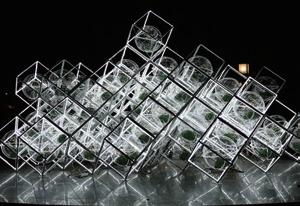
This yearly celebration takes place from mid-to-late June to late July at Qixing Park, Beitou Park, and surrounding areas in Beitou District. Visitors will encounter large-scale installations highlighting local cultural elements, and there will be more than 100 local stores participating in activities held on weekends and holidays. Multiple themed parties and performances by well-known artists are sure to draw a large crowd.
Beitou Park, Qixing Park, and Qihu Park 北投公園、七星公園、七虎公園
July 5-July 28
#04
Tianmu Beer Festival 天母啤酒節

This annual happening, brimming with international flair, is held in the Tianmu Sports Park. Tianmu restaurants and pubs introduce you to different beer cultures from around the world, and there is live music entertainment featuring vocal artists and DJs. A prominent feature of the festival is a large installation artwork depiction of the event mascot, “Mr. Yeast,” inviting everyone to explore Tianmu.
Tianmu Sports Park
天母運動公園
July 20-21
4 SEASONAL HIGHLIGHTS

#05
Taipei Summer Festival
This annual festival is held at Yanping Riverside Park (Dadaocheng Wharf). Highlights are beautifully decorated yachts, fireworks shows, and delicious local and international food and drink by the riverside. Businesses in the area also present visitors with exclusive special offers. This is one of the most representative summer events in Taiwan, during which tourists get to experience the elegance of old Taipei’s riverside areas, including Dihua Street in the Dadaocheng neighborhood. This year, there will be four fireworks shows – including a grand finale to end the festival – accompanied by live stage performances and food and cultural-creative markets. Visitors can also go on river yacht cruises and enjoy romantic walks through a light art installation corridor in the riverside park.
Flood Gate 3-5, Yanping Riverside Park 延平河濱公園 3 號至 5 號水門
July 17-August 10
taipeisummer.travel.taipei
©Department of Information and Tourism

©Department of Information and Tourism

5 SEASONAL HIGHLIGHTS
大稻埕夏日節
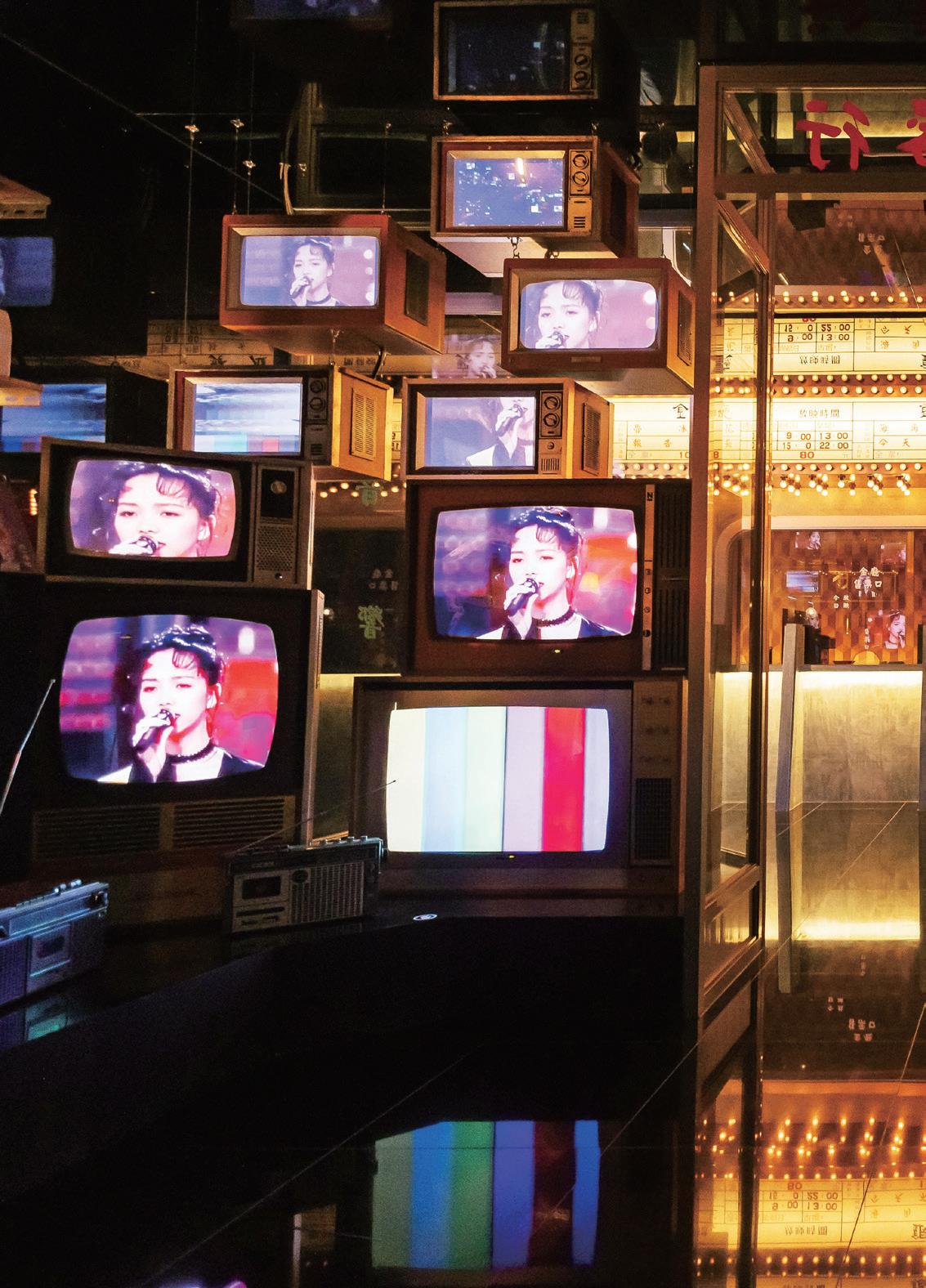
Eastern Taipei After Dark
Discovering Lesser-Known Evening Attractions in Songshan and Nangang Districts
TEXT | HAN CHEUNG PHOTOS | VISION, DEPARTMENT OF INFORMATION AND TOURISM
Taiwan’s busy yet mild-mannered capital comes alive after the sun sets. Whether you want to party it up, watch a live performance, or just relax by the river, there’s always a reason to stay out just a bit longer. Don’t worry about sustenance, as chances are there’s an eatery, night market, or 24-hour convenience store conveniently near at hand.
Taiwan pop music exhibition inside the Taipei Music Center's Cultural Cube
COVER STORY 6

Located in the quieter eastern part of Taipei City, Songshan and Nangang districts do not immediately come to mind when it comes to nightlife – even though the former is home to the popular Raohe Street Night Market
The area around this market was one of Taipei’s most prosperous neighborhoods during the 1800s due to the bustling Xikou Wharf on the Keelung River. Renamed Songshan in 1920, Xikou diminished in importance over the 20th century, but the opening of the night market in 1987 rejuvenated it as a commercial hotspot. After sampling the market stalls and brick-and-mortar operators, people often visit Songshan Ciyou Temple (in existence since 1753) or relax in the close-by riverside park. Today’s Songshan District encompasses a much larger area than the original Xikou area, and is a major financial hub and shopping district. Among its other attractions are the Taipei Arena and Minsheng Community. Interestingly, the popular Songshan Cultural and Creative Park is situated in Xinyi District rather than Songshan. So, as you explore, keep this distinction in mind to avoid any confusion.
Home to the national research hub Academia Sinica, the sleepy district of Nangang wasn’t incorporated into Taipei until 1968. It was mostly developed as an industrial district, with little to offer tourists, but things have changed in recent decades with the completion of the Nangang Exhibition Center in 2008 and the transformation of the Nangang Railway Station into a major transport center where Taipei Metro, Taiwan Railway, and Taiwan High Speed Rail services meet. The Citylink mall built above the station in 2014 brought life to a nondescript stretch of Zhongxiao East Road, and since 2020 the adjacent brand-new Taipei Music Center complex has further boosted entertainment opportunities in the area.
COVER STORY 7
Songshan District
Those hankering for a brief respite from the hubbub of the concrete jungle need not go far. One of Taipei’s most pleasant features is its network of verdant riverside parks, separated from the rest of the city by flood walls. An excellent system of cycling and walking paths is part of these parks, the paths running along both banks of the Tamsui, Keelung, Xindian, and Jingmei rivers and connecting with surrounding New Taipei City.
One scenic and easily accessible choice is Chengmei Left Bank Riverside Park, just north of Raohe Street Night Market and a 5min walk from the MRT Songshan Station. It sits on the former location of the once-bustling Xikou Wharf. For more than a century, all river-transport vessels traveling between the Tamsui River wharfs in the settlements of Dadaocheng and Bangka to the west and toward the major seaport of Keelung to the northeast had to stop at Xikou.
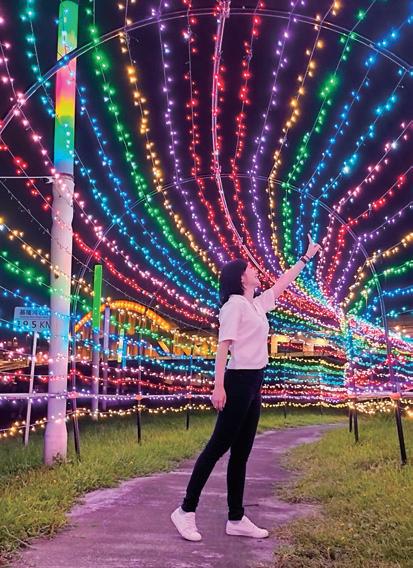
While Xikou as a whole remained a commercial center, the wharf fell into disuse due to the completion of a Keelung-Taipei railway in the late 1800s and sediment buildup in the river, which made boat navigation difficult.
Completed in 2007, the mildly S-shaped pedestrian Rainbow Bridge connects Chengmei Left Bank Riverside Park and Chengmei Right Bank Riverside Park in the Songshan and Neihu districts, respectively, and is noted for its bright-red supporting arch. This walkway is an ideal spot to gaze upon sweeping vistas of river, mountains, and cityscape and to watch the sunset. Illuminated in changing colors at night, the bridge’s intersecting curves and upside-down reflection in the water is a favorite for photographers – especially with the yellow, doubledecker arched First MacArthur Bridge in the background.
Many joggers and cyclists pass through the park on their exercise routines, while others come to enjoy the summer breezes and have a picnic. Due to its proximity to the night market, it’s a delightful spot for a digestion-aiding stroll after a hearty meal.
The love-themed plaza below the bridge, featuring a large public-artwork sculpture of the word LOVE, is a popular spot for couples to canoodle, complete with love seats and a path displaying the word “love” in 12 different languages. The LOVE sign has a wire mesh behind the letters for amorous visitors to place padlocks as a symbol of their unions. People used to throw the key into the river afterward; to discourage such behavior, the city has set up a “love mailbox” next to the sign for key depositing.
Until the end of June, visitors will be treated to a dazzling symphony of light, sound, and color during the Taipei Water Dance Festival, with spectacular water patterns streaming from below and above the bridge. The different themed displays are each 5min long, taking place every 30min from 7pm to 9pm daily, and the closing ceremony on June 30 will showcase some of Taiwan’s hottest musical acts. As well, check out the 40m-long LED rainbow corridor and rainbow wall installations.
LED rainbow corridor ©Department of Information and Tourism COVER STORY 8


of Information and Tourism ©Department of Information and Tourism LOVE sign in Chengmei Left Bank Riverside Park COVER STORY 9
The Rainbow Bridge during the Taipei Water Dance Festival
©Department
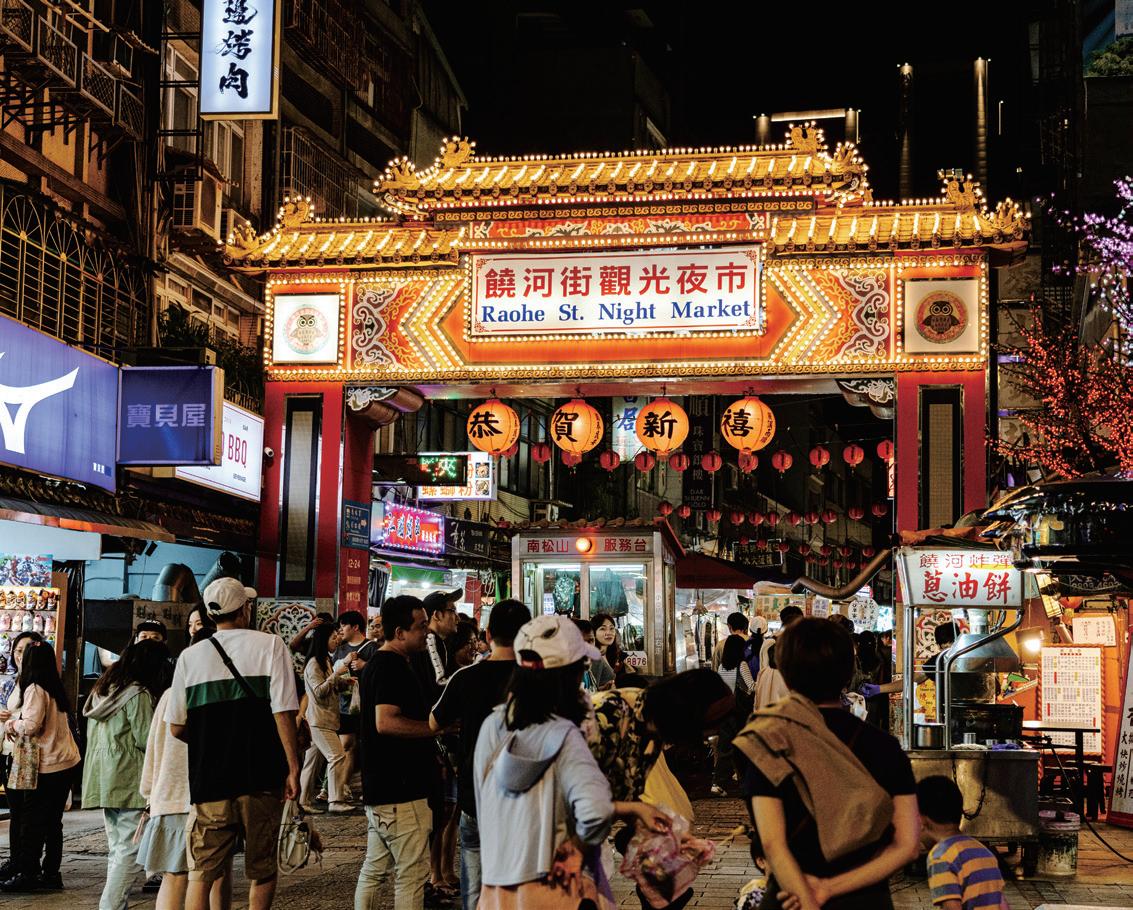
Brightly lit up at night, the impressive six-story Songshan Ciyou Temple is a major landmark in the Xikou area. Located at the eastern entrance of Raohe Street Night Market, visitors are welcome to drop by and learn about Taiwan’s temple culture while marveling at its intricate architectural and decorative motifs. Established in 1757 by a wandering monk, the temple’s principal deity is Mazu, Goddess of the Sea, who protected the cargo craft and fishing vessels that dotted the Keelung River during Xikou’s heyday. The square temple structure has undergone numerous renovations and expansions over the centuries.
Make sure you enter the spacious main hall through the right-side door. Beyond Mazu, a Daoist deity, numerous other Daoist and Buddhist deities are also housed here, some offering specific services pertaining to childbirth, love, prosperity, health, and academic success. The temple has worshiping instructions for those inclined.
A quiet artery by day, the unassuming Raohe Street wakes up at dusk as vendors arrive with their metal carts, neatly lining them up as hungry locals and tourists trickle in. Overshadowed by rapid development in the neighboring Daan District, Xikou suffered a major blow in 1975 when a street-widening project in the area caused many businesses to relocate. Xikou Street, renamed Raohe Street after World War II, barely saw any

10
Raohe Street Night Market

commercial activity over the next decade-plus, until the night market opened in 1987.
While jewelry, clothes, souvenirs, and other household goods are also sold here, the main draw is undoubtedly the food. You’ll find the whole catalog of Taiwanese snack staples here, such as fried chicken, grilled squid, stinky tofu, oyster vermicelli, and scallion pancakes, along with Japanese, Korean, and other international-cuisine delectables.
A long queue can be seen just inside the street’s eastern entrance as people wait patiently for the famous Fuzhou Black Pepper Bun , which are baked on the inside walls of large urns. The porkfilled pastries are slightly burnt and crunchy on the outside, but the inside is juicy with a hint of black pepper. Chen Dong Pork Ribs Medicinal Herbs Soup are also a favorite, the tender meat slow-cooked in a traditional Chinese medicinal broth. Cool off with Yu Pin Yuan’s refreshingly sweet “ice and fire” glutinous rice balls, which come in sesame and peanut flavors.
With most of Taiwan’s indigenous settlements concentrated in the eastern and southern parts of the island, there are few opportunities to sample tribal foods in Taipei. Opened last year, Cinunan Indigenous Restaurant is somewhat hidden behind the elevated overpass to the First MacArthur Bridge at the end of Nanjing East Road. It’s just a 5min walk from Raohe Street Night Market’s western entrance, and about a 10min stroll from MRT Nanjing Sanmin Station.
Decorated with motifs from the Paiwan culture centered on Pingtung County in the island’s far south, Cinunan means “hunter” in the Paiwan language. The menu is mostly a mix

of dishes from the mountain-dwelling Paiwan and maritime Amis (or Pangcah), Taiwan’s most populous indigenous group, which inhabits the coastal region of Hualien and Taitung counties. Glutinous rice steamed in a bamboo tube and cinavu (leaf-wrapped food containing millet, rice or taro), millet with pork wrapped in shell ginger leaves, make up the starch staples, and among the distinctive seasonings are magao (mountain peppercorn) and prickly ash leaves. Barnacles, grilled fish, sausage, salted pork, and a wide range of wild vegetables round out your savories.
The atmosphere gets quite lively as the night goes on, with parties at each table taking turns belting out karaoke tunes. Musicians put on lively interactive shows on Saturday evenings. The bar downstairs offers a wide range of libations, including millet wine and rice wine cocktail indigenous specialties.
Please drink responsibly
FUZHOU BLACK PEPPER BUN
福州世祖胡椒餅 3:30pm-11:30pm
CHEN DONG PORK RIBS MEDICINAL HERBS SOUP
陳董藥燉排骨 4:30pm-11:00pm, closed on Tuesday
YU PIN YUAN
御品元冰火湯圓 5:00pm-12:00am
CINUNAN INDIGENOUS RESTAURANT
祈駑南原住民餐酒館
393, Sec. 5, Nanjing E. Rd., Songshan Dist. (02) 8787-1157 6:00pm-3:00am instagram.com/cinunan_
 Songshan Ciyou Temple Specialties from the indigenous Paiwan and Amis peoples
Songshan Ciyou Temple Specialties from the indigenous Paiwan and Amis peoples
COVER STORY 11

Nangang District
The opening of the Taipei Music Center in 2020 further transformed the once-unmemorable Section 7 of Zhongxiao East Road into a buzzing hotspot. Located about a 10min walk from MRT Kunyang Station, the multipurpose complex contains a state-of-the-art concert hall that can accommodate 5,000 people, an exhibition building showcasing Taiwan’s storied pop music history, music-oriented shops, an outdoor plaza for events, and a variety of bars, cafés, and restaurants.
As Asia’s first center dedicated exclusively to popular music, the compound also serves as an incubator for musical talent, with classrooms and practice and performance spaces as well as recording and production studios, connecting the different ends of the industry in one location.
Taiwan has long been a major hub for Mandarin pop music, and its artists have enjoyed much popularity in China, Singapore, Malaysia, and the Chinese-speaking communities in the US and other locales. Many foreign musicians have also enjoyed long and successful careers here, using Taiwan
 Old cassette tapes on display in the Cultural Cube
Old cassette tapes on display in the Cultural Cube
COVER STORY 12
The Cultural Cube's Music, Island, Stories: Pop Music in Taiwan exhibition introduces you to a century of pop music in Taiwan
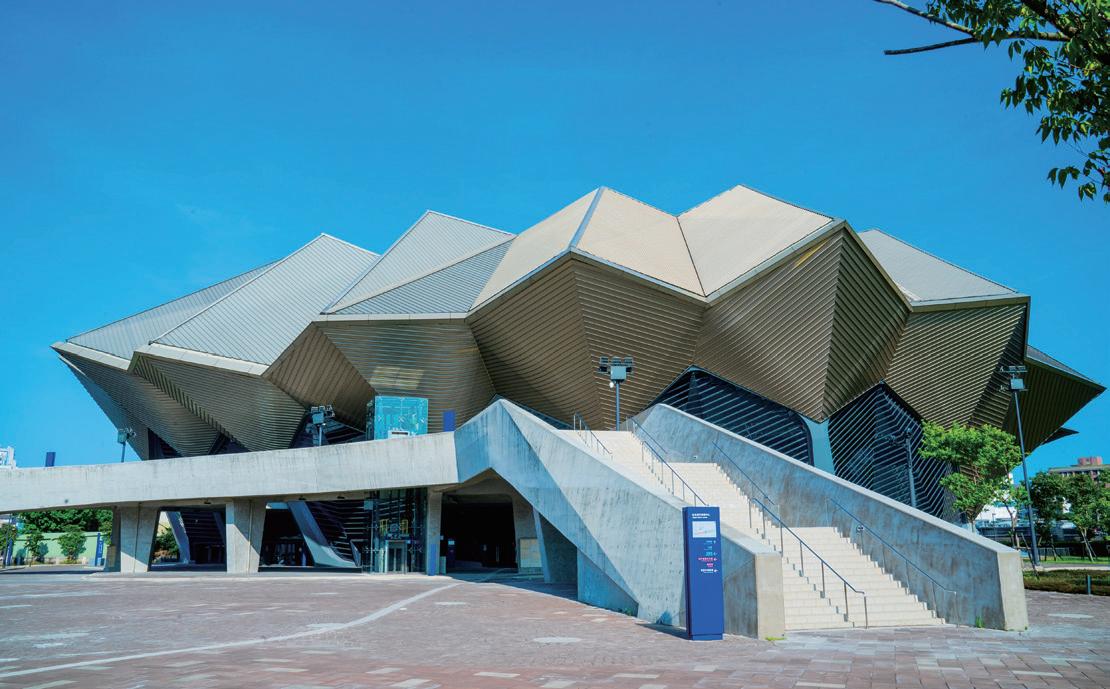
as their base. On the other hand, during the martial law period the Taiwanese-language scene persisted despite government suppression, and in recent decades Hakka and indigenous artists have been emboldened to draw from their cultural backgrounds, melding elements of their heritage with metal, hip-hop, EDM, and other trendy stylings. With this increased diversity and acceptance of musical genres once relegated to the “underground,” Taiwan’s popular music scene is now richer than ever.
Learn about this history at the Cultural Cube’s Music, Island, Stories: Pop Music in Taiwan permanent exhibition, which takes visitors on an immersive journey covering an entire century from the 1895~1945 Japanese era to the modern day. The exhibit rooms are thoughtfully designed to transport visitors back in time, and more than 1,000 fascinating artifacts are on display. Your journey concludes with a simulated concert experience with panoramic projections and lighting effects. It’s clear here that “pop” music doesn’t just refer to the musical genre; it’s more about artists and movements that have left a lasting impact on Taiwanese society and culture – whether it be reflective ballads, campus folk, or heavy metal.
Both music lovers and professionals will enjoy browsing the shops located in the complex, including specialty boutiques for accordions, saxophones, pianos, guitars, speakers, and DJ equipment. The DaTao Vinyl Records Store offers more than 30,000 records that can be enjoyed using earphones, record players, and sound systems in a cozy setting.
The spaceship-like Concert Hall, shape design inspired by Taiwan’s majestic mountains, regularly hosts some of the biggest domestic and international artists, as well as such major events as the Golden Melody Awards, Golden Indie Music Awards, and season two finale of the hit The Rappers hip-hop competition.
The Taipei City Government is also putting on the Taipei Focus music festival (Sept. 2-8), which will connect the center with local businesses and creatives in the Nangang and Xinyi districts.
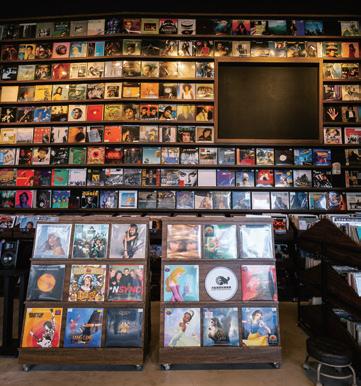
TAIPEI MUSIC CENTER
台北流行音樂中心
99, Sec. 8, Civic Blvd., Nangang Dist. (02) 2788-6620 www.tmc.taipei/en
DATAO VINYL RECORDS STORE
大韜黑膠耳機專賣
99, Sec. 7, Zhongxiao E. Rd., Nangang Dist. (02) 2785-7275 facebook.com/DaTaoVinyl
DaTao Vinyl Records Store
13
Concert Hall of the Taipei Music Center
The Taipei Music Center transforms into an atmospheric setting to unwind at night as multicolored lights give ambiance to the futuristic buildings and complex grounds. Eight light-art installations created in collaboration by musicians and artists can be found on the lawns extending from each end of the main buildings, encouraging visitors to explore the vicinity.
There has long been a lack of options for after-hours activities in Nangang, given its modern history as an industrial and residential zone somewhat isolated from the city center. Until recently, most partygoers headed straight to Xinyi or Daan districts for entertainment, but things began to change with the establishment of the Citylink shopping complex. The Taipei Music Center added to the district’s offerings with the opening of Kafka by TMC live music bar in 2022, and today it has several more options – including a coffee shop that stays open until 2am, a concept previously unheard of in Nangang.
Electric guitar installation artworks guide the way to Kafka by TMC, a resto-bar on the 5th floor of the Taipei Music Center’s crystal-shaped Creative Hub building, which currently provides live music by up-and-coming artists every Saturday in addition to special events. It’s a convenient place to grab a bite or drink after enjoying a performance or touring the Cultural Cube, which closes at 6pm.
Kafka by TMC is considered a continuation of Kafka by the Sea, a beloved indie stomping ground in the city’s south-section Gongguan neighborhood, which closed down in 2022 after 17 years in business. The industrial-chic interior is complemented


 Kafka by TMC has a small stage for live music performances
Kafka by TMC has a small stage for live music performances
COVER STORY 14
Pub grub served by Kafka by TMC to complement the experience
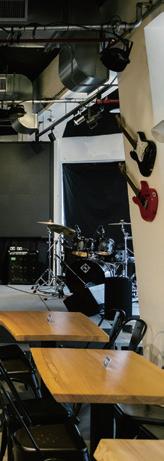



by natural wood and plants, and the floor-to-ceiling windows provide ambient lighting and intriguing views of the Creative Hub’s crisscrossing beams as well as the surrounding area. The food menu consists of a smattering of international fare, including Thai minced pork rice, tonkatsu ramen, spaghetti, and a variety of salads and appetizers. The crispy German-style pork knuckles are an especially hot-order item. There are also desserts and a selection of drinks, including draft beers and beer-based fruit cocktails.
Make sure you check ahead for that day’s opening hours, as the venue is sometimes booked for private events.
While Kafka by TMC closes at 10pm, a newly opened row of establishments on the side of the Cultural Cube keeps the party going by staying open until midnight on weekdays and 2am on weekends. Collectively known as the W9T Area, these attractions offer mostly outside seating with periodical live performances.
Patrons can purchase a bottle of craft beer or wine from the dizzying array of choices at the W9T “convenience store” (ask the staff for recommendations), order a Mandopop-themed draft cocktail from Hold On Draft, or sample Japanese sake, plum wine, and whiskeys at Chotto Sake bar. Those who prefer to sit inside can visit Take Your Time Café and sip on alcoholic or nonalcoholic coffees, teas, or soft drinks. The area shares a food menu, which includes meat pies, pizzas, French fries, cold cuts, and a variety of fried appetizers.
KAFKA BY TMC 北流卡夫卡
99, Sec. 8, Civic Blvd., Nangang Dist. (02) 2785-1777
Tue. to Sun. 11:30am-10:00pm taipeikafka.com.tw
Bangka | 艋舺
Chengmei Left/Right Bank Riverside Park 成美左 / 右岸河濱公園
Dadaocheng | 大稻埕
Minsheng Community | 民生社區
Nangang Exhibition Center | 南港展覽館
Rainbow Bridge | 彩虹橋
Raohe Street Night Market | 饒河街夜市
Songshan Ciyou Temple | 松山慈祐宮
Songshan Cultural and Creative Park | 松山文創園區
Taipei Arena | 台北小巨蛋
Taipei Focus | 台北潮國際
Taipei Music Center | 台北流行音樂中心
Taipei Water Dance Festival | 台北水舞嘉年華
W9T Area | 酒等了
Xikou Wharf | 錫口碼頭
 MAP
Both hard and soft drinks can be enjoyed in the W9T Area
Please drink responsibly
MAP
Both hard and soft drinks can be enjoyed in the W9T Area
Please drink responsibly
COVER STORY 15
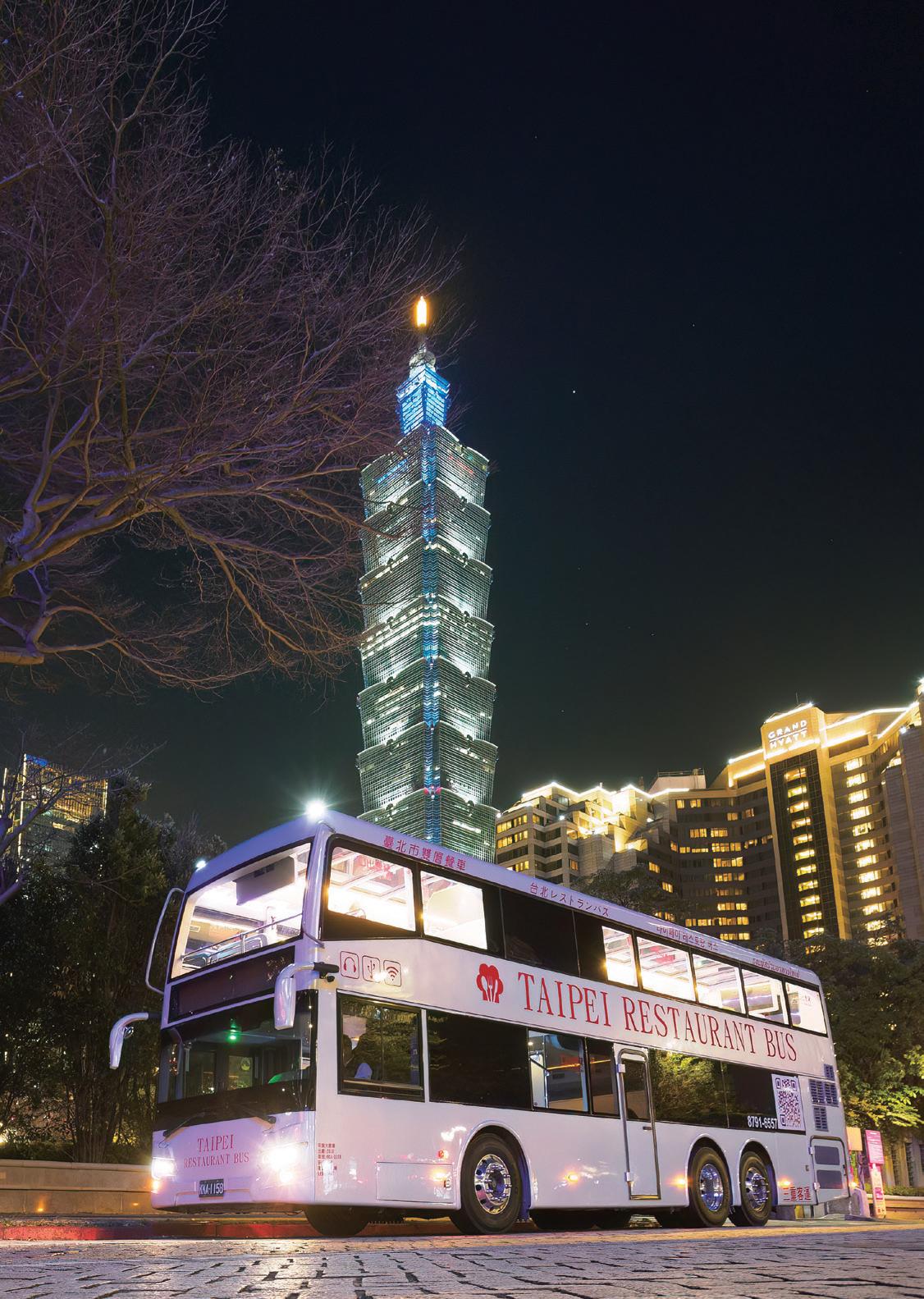
Panoramic City Rides
Tourists Enjoy Splendid Views and Gourmet Cuisine on Taipei Sightseeing Buses
While the Taipei Metro is the most convenient way to get around Taipei, visitors miss out on seeing much of the city while underground. The open-top double-decker tourist buses of the Taipei Sightseeing Bus hop-on/hop-off service offer unique views of the cityscape, stopping at most of the prime destinations in the urban core.
TEXT | HAN CHEUNG PHOTOS | TAIPEI SIGHTSEEING BUS
The bright-red double-decker tourist buses run on two lines through the city, with audio guides available in English, Chinese, Japanese, and Korean introducing you to sights along the way. Passes lasting 4 to 48 hours allow tourists to hop on and off at any of the 31 stops on both the Red and Blue lines. Most passengers, however, prefer to stay on for the whole trip, treating it as a quick introductory tour of the city.
The full Red Line journey takes about 60 minutes (seven services a day), the Blue about 70 minutes (five services a day); for departure times, check out the timetable on the official website. While the main draw is the semi-open-air upper deck, those who can’t bear the summer heat may opt for the air-conditioned lower level. A cooling mist is periodically sprayed, and free Wi-Fi is provided.
The Red Line cuts through the heart of the city core. Leaving Taipei Main Station heading west, your bus passes by the picturesque North Gate (Beimen), once the main entrance to the old walled city, before heading for the trendy Ximending shopping and entertainment district. Next, it passes historic Bangka Lungshan Temple , and passengers can get a glimpse of the Presidential Office Building and other Japanese-era government
buildings as it makes its way toward the Chiang Kai-shek Memorial Hall and its iconic Liberty Square arch.
Traversing down Xinyi Road toward the Taipei 101 skyscraper, currently the 11th tallest in the world, passengers can observe daily life in one of the city’s most prosperous areas. Your bus returns to the Taipei Main Station via bustling Zhongxiao East Road, with sites of interest including Dr. Sun Yat-sen Memorial Hall and Huashan 1914 Creative Park.
For more information about the Taipei Sightseeing Bus service, visit taipeisightseeing.com.tw.
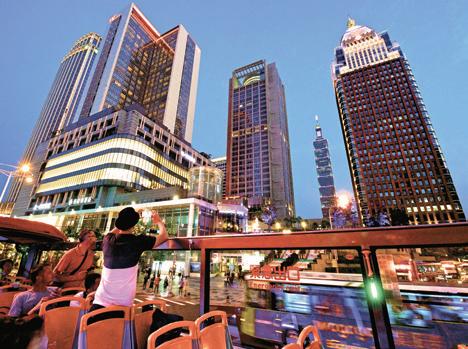

17 COVER STORY
Taipei Sightseeing Bus passing Ximending
The double-decker service got fancy in 2021, as an additional bus was transformed into a moving restaurant with starred gourmet meals offered during cruises through Taipei’s ritzy Xinyi District. Passengers on this Taipei Restaurant Bus dine at one of the 26 table seats on the upper deck, featuring a glass top to allow gazing up at the area’s towering buildings – including Taipei 101. The tables are designed to minimize shaking, and staff on board serve the meals while introducing selected sights. Remember that there are no bathrooms for the 90 to 120min journey, so make sure to take care of matters beforehand.
Four rides depart daily, except for Mondays, launching from in front of the Breeze Xin Yi mall, just outside MRT Taipei City Hall Station’s Exit 3. The service is offered in partnership with different restaurants/hotels every season; currently, the food is being provided by the five-star Regent Taipei hotel. On the lunch menu is the hotel’s award-winning braised beef noodles, which CNN named in 2015 as Taipei’s top selection. In the afternoon, freshly brewed tea is complemented by a delightful array of sandwiches and pastries while the four-course dinner, featuring either succulent chicken or tender beef brisket, left a lasting impression of culinary excellence on this writer.
Among the shiny Xinyi District malls and highrises that your bus rolls by is the twisting, double helix-shaped Agora Garden. The roof and exterior are adorned with approximately 23,000 trees and shrubs, almost as many as found in New York’s Central Park. This verdant expanse serves not only to enhance aesthetics but also to absorb about 130 tons of CO2 emissions annually. The eco-friendly residential complex is Taiwan’s priciest. The journey pauses for a while in front of Taipei 101 so that diners can linger over the view while they finish their food and pose for photo ops afterward.
The trip concludes with a jaunt along the pleasant, tree-lined Renai Road, through the vibrant East District, and by the stately Dr. Sun Yat-sen Memorial Hall.
Earlier this year, in addition to the original black bus, a second bus with a stylish silver exterior was put into service, catching more attention especially after nightfall.
For more information about the Taipei Restaurant Bus service, visit taipeirestaurantbus.com.
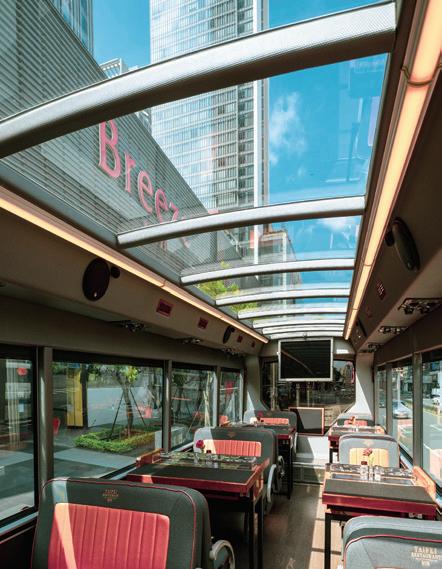


18 COVER STORY
The restaurant bus has a glass roof
The recently introduced second Taipei Restaurant Bus can be seen shuttling through the city
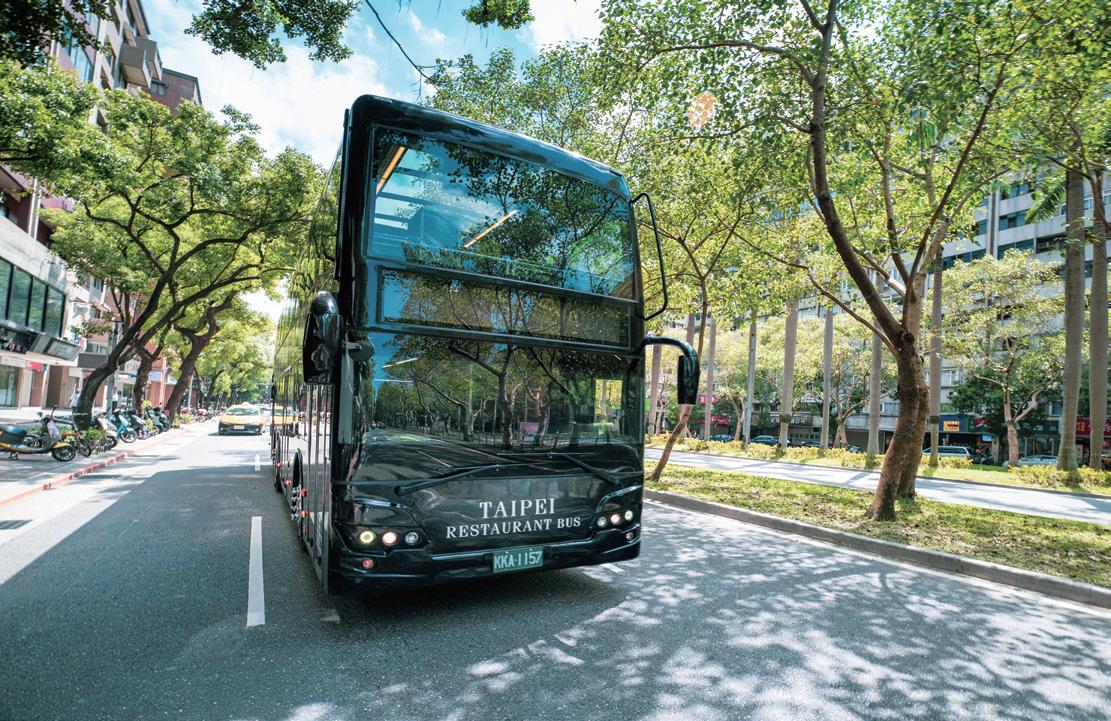
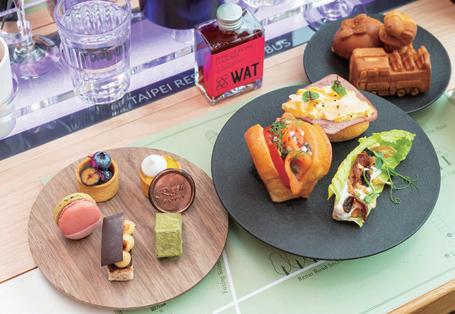
Bangka Lungshan Temple | 艋舺龍山寺
Chiang Kai-shek Memorial Hall | 中正紀念堂
Dr. Sun Yat-sen Memorial Hall | 國父紀念館
Huashan 1914 Creative Park | 華山1914文化創意產業園區
Liberty Square | 自由廣場
North Gate | 北門
Presidential Office Building | 總統府
Taipei 101 | 台北101
Sec.
Taipei Restaurant Bus | 台北雙層餐車
Taipei Sightseeing Bus | 台北市雙層觀光巴士 Ximending | 西門町
19 COVER STORY
Agora Garden
Songren Rd. Songshou Rd.
Taipei City Hall (South Gate)
Sec. 1, Fuxing S. Rd.
Sec. 4, Renai Rd. East District
4, Zhongxiao E. Rd.
MRT Taipei City Hall Station
Sun Yat-sen Memorial Hall
Taipei City Hall (East Gate) Songgao Rd.
Taipei City Hall (West Gate)
Enjoy afternoon tea while taking in the street view of Taipei
Taipei Restaurant Bus Route
An Eye - Opening
Opera Experience
TAIPEIEYE: ENTER A WORLD OF HIGH-PITCH SINGING AND ACROBATIC DANCE
From roadside glove puppetry during temple festivals to indigenous dances at cultural fairs and Chinese orchestral recitals at the National Theater & Concert Hall, opportunities to enjoy Taiwan’s diverse traditional performing arts can be found around every corner in Taipei. A longstanding local favorite is traditional opera, and both the Taiwanese gezaixi (Taiwanese opera) and Peking varieties have flourished on the island for more than a century.
TEXT | HAN CHEUNG
PHOTOS | TAIPEIEYE, VISION

20 COVER STORY



Make sure you arrive early for an opera performance at TaipeiEYE, as the activities start an hour before the actual curtain time of 8pm. Dubbed Taiwan’s first “tourist theater” showcasing the island’s myriad traditional arts when it opened in 2002, the venue provides visitors with an up-close look at performers applying their makeup and hairpieces, as well as the chance to try on colorful costumes and accessories for photo ops. Live music, artifact displays, and craft activities are also available.
After a four-year pandemic hiatus, TaipeiEYE finally reopened in February 2024 with three action-packed, visually dazzling Peking opera productions in a row. The 60min shows run every Wednesday, Friday, and Saturday, with subtitles in Chinese, English, Korean, and Japanese shown simultaneously beside the stage. Staff who speak the foreign languages are available on site.
Located in the imposing Taiwan Cement Building, TaipeiEYE was launched by the prominent Koo family, whose passion for Peking opera dates back to 1915 when Koo Hsien-jung inaugurated the Taiwan Novel Hall in the city’s historic Dadaocheng area. Unfortunately, the theater was destroyed in a US airstrike during World War II.
More than four decades later, the late Koo Chen-fu resumed his father’s mission. Through the C.F. Koo Foundation, he revived the Novel Hall in 1997 and founded the Taipei Li-yuan Peking Opera Theatre. The troupe’s members also perform at TaipeiEYE, which aims to promote not just opera but also other traditional Chinese and Taiwanese art forms to foreign visitors.



21 COVER STORY



The lobby outside the main stage at TaipeiEYE is teeming with activity on a Friday night. At the activity booth, adults are making lino prints of auspicious images while children are coloring intricate Peking opera makeup onto a blank face on paper. Further in, visitors are trying on different opera costumes – including various beards and weapons – while a musician plucks soothing notes on a guzheng (Chinese zither). Two performers are applying makeup to their own faces, while a third offers the service to audience members.
Peking opera first became popular in Taiwan around the turn of the 20th century during the 50-year period of Japanese rule, and locals such as Koo Hsien-jung would regularly invite troupes from China to perform. Taiwanese gezaixi, on the other hand, developed locally from the opera styles brought by Han Chinese settlers from China’s southern Fujian Province, emerging in the late 1800s as a distinct art form.
Both styles have seen their fortunes rise and fall due to changes in the political and cultural climate, and although local interest in traditional opera has waned in the past few decades, a number of troupes continue to keep the craft alive and relevant. While TaipeiEYE focuses on opera as its main program, it will periodically showcase other traditional arts such as indigenous dance, lion dance, puppetry, and acrobatics.
Tonight’s show is Legend of the White Snake, based on a Tang Dynasty folktale about a thousand-year-old snake who assumes the form of a beautiful woman and falls in love with a handsome young scholar. A small crowd gathers around the main actress as she slowly transforms herself into character, first painting her face and then painstakingly putting on the hair pieces and headgear with the help of an assistant.

22 COVER STORY
Taiwanese opera, Chen San and Wu Niang
Peking opera, Legend of the White Snake

The first half of Legend of the White Snake focuses on storytelling and dialogue in the artform’s customary highpitched voicings. There are minimal props, as the tension is driven by miming and dance-acting as well as the dramatic soundtrack provided by the accompanying orchestra. Things shift into high gear as the final battle ensues, skilled performers taking the stage by storm in a vibrant, eye-catching whirlwind of choreographed combat and acrobatics. The audience is moved to cheering and applauding with every impressive move.
TaipeiEYE’s brand reopening in February highlighted the Peking opera classic Monkey King, featuring the mischievous titular character who wreaks havoc upon the heavens. It then presented Monkey King Battles the Cave Rats , where the reformed trickster protects Buddhist monk Tang Sanzang from evil spirits on their journey to retrieve scriptures from India.
In May the program switched to Taiwanese opera with Chen San and Wu Niang, a love story set in southern China. Presented by the Shintrun Taiwanese Opera Troupe , this production was comparatively dialogue-heavy, with performers relying more on their acting and singing skills than acrobatic prowess. In June, Legend of the White Snake is back
TAIPEIEYE 臺北戲棚
113, Sec. 2, Zhongshan N. Rd., Zhongshan Dist. (02) 2568-2677 www.taipeieye.com
C.F. Koo Foundation | 辜公亮文教基金會
Dadaocheng | 大稻埕
Koo Chen-fu | 辜振甫
Koo Hsien-jung | 辜顯榮
National Theater & Concert Hall | 國家兩廳院
Shintrun Taiwanese Opera Troupe | 薪傳歌仔戲劇團
Taipei Li-yuan Peking Opera Theatre | 台北新劇團
Taiwan Novel Hall | 臺灣新舞台

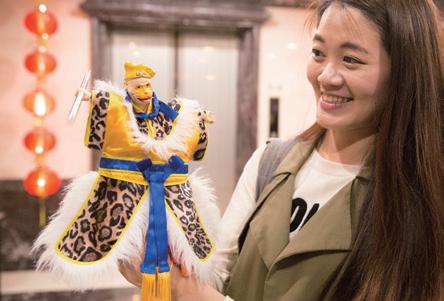
on stage, along with another Peking opera featuring the Monkey King titled The Leopard
After each show, audience members can pose for photos and chat with the performers in the lobby, and many linger long after the finale.
23 COVER STORY
Peking opera, Monkey King
Performer applying makeup
At TaipeiEye, learn about traditional puppetry as well
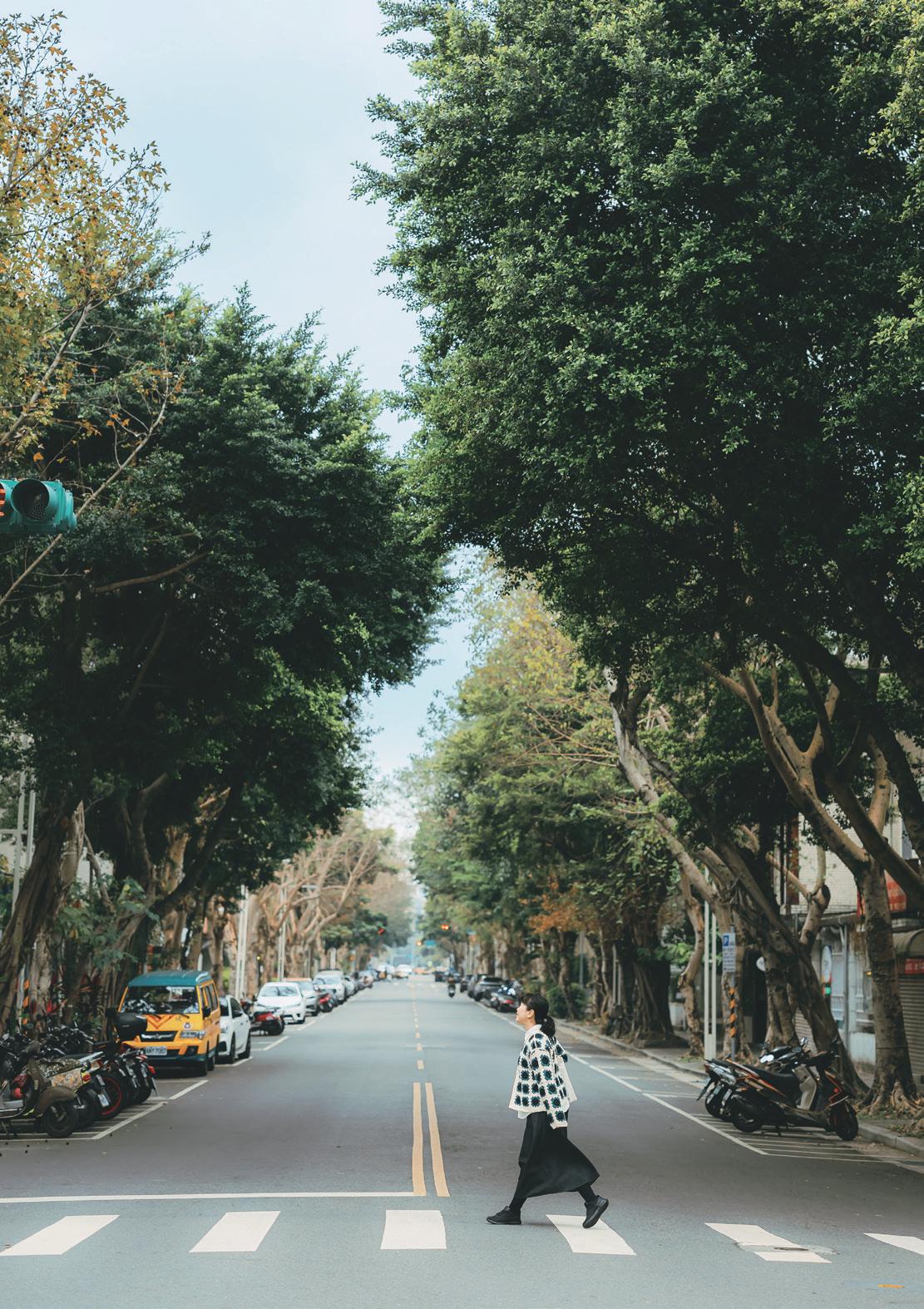
The Genteel Minsheng Community The Genteel Minsheng Community
Good Living and Touring Down Along Shady Lanes
Taipei is a city that, at first sight, seems like a forest of tall buildings. Dip into areas behind the major thoroughfares, however, and you find many a “small” thriving community. Among the most characterful is the Minsheng Community, which boasts a large number of neighborhood parks, thickly leaf-shaded arteries, artsy cafés and restaurants, concept boutiques, and a noticeably slower, quality-oriented cosmopolitan approach to living.
CHARETTE PHOTOS | VISION 24 A DAY IN TAIPEI
TEXT | RICK
Let’s head out on a breezy dappled-sunlight outing sampling six leisure-oriented enterprises that will give you a feel for this neighborhood’s pulse. By the way, about those trees, primarily banyan and bodhi (sacred fig) –Minsheng Community originally took shape in the 1960s, a Taipei City Government urban-development initiative, as Taipei’s first Americanstyle model community. Proximity to Taipei Songshan Airport made its low-rise residential buildings a must. Fujin Street is the community’s heart, and the highlight for our sampler experiences.
MRT Songshan Airport Station
Songshan Airport but. (we love butter)
We start our day by taking Taipei Metro’s Brown Line to MRT Songshan Airport Station. After leaving the station by Exit 3, we turn south, cross Minquan East Road, and head to our first stop on Fujin Street.
With a name like but. (we love butter), what pray tell do you think you’ll be experiencing upon walking through this shop’s door? Answer: Frenchstyle butter cookies, biscuits, soft candy, and donuts. Entering is itself an adventure – the façade and inner entry area are set up like a highfalutin British tailor shop. The pastry shop, looking like a fashionable speakeasy with diner seating, is found through the last of a series of short-hallway doors. The sweet creations are French in inspiration whilst starring such quintessential Taiwan-produced ingredients as pineapple, longan, almond, honey, and rice.


WOLF TEA 琅茶本舖


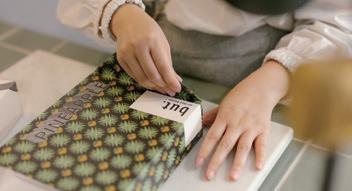
www.but.com.tw
Mon. to Fri. 1:00pm-8:30pm Sat. and Sun. 12:30pm-8:00pm


8, Aly. 6, Ln. 97, Sec. 4, Minsheng E. Rd., Songshan Dist. 0970-844-235
wolftea.com
Mon. to Sat. 1:00pm-7:00pm
It’s just a walk of two minutes from the pastry shop to the following tea store, located in one of the community’s quiet tree-shaded alleys.
Wolf Tea specializes in single-origin Taiwan teas, celebrating the island’s marvelous mosaic of terroir excellence and ultimate craftsmanship. Its menu is ever-changing, for its experts are constantly traveling the hills and mountains to source the best leaf “picked by outstanding tea masters at the most suitable weather moments in the highest-quality tea gardens each season.” The shop décor is a mix of Scandinavian blonde elements along with wood-plank flooring, cabinets, tables, and chairs that would be right at home in a well-lived-in North American farmhouse, while the tea accouterments are classic-style Chinese.
Wolf Tea
Fujin Tree 355
Vintage & Deco Restaurant Pinecone
Coffee Essential
BUT. (WE LOVE BUTTER) 102, Fujin St., Songshan Dist. (02) 2547-1207
Sec. 4, Minquan E. Rd.
Sec. 4, Minsheng E. Rd.
Fujin St.
25 A DAY IN TAIPEI
Dunhua N. Rd.
If you prefer coffee over tea, you might enjoy following us to our next stop, a fine café, located in another tree-lined alley 5min. on foot southwest from the tea shop.
Taipei (and all of Taiwan) has seen an explosion of cafés over the past 15 years as the younger generation seeks an alternate path to office careers, making it difficult to distinguish yourself from the crowd. Coffee Essential has risen to the top, acquiring a brand reputation as the crème de la crème.
The wide front is an almost solid wall of glass, allowing sunlight to pour in by day and a softlighting inner glow to radiate outward at night. Inside, the stained wood of the long serving bar (seating before it) and the tables have a (deliberately) weathered look, the original cement floor has a mottled pattern, a full red-brick wall has been left exposed, and industrial lighting is used –the overall effect one of rough and ready homey simplicity. Beyond the flavorsome specialty coffees and teas, Western-style light foods (frittata, croque madame, etc.) and desserts (homemade cheesecake, crème brulee, etc.) as well as craft beers and cocktails are served.
COFFEE ESSENTIAL 民生工寓
3, Aly. 1, Ln. 56, Sec. 4, Minsheng E. Rd., Songshan Dist. (02) 8712-1220
instagram.com/coffee.essential.cbar 11:00am-7:30pm

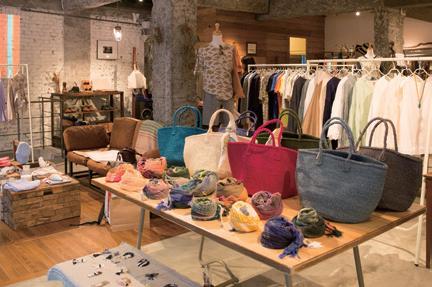
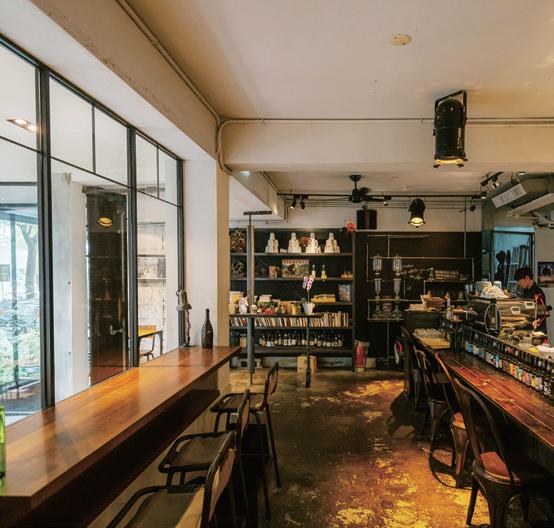

Next up, let’s head to a boutique selling stylish fashion. For this, we walk back to Fujin Street, about 12min. from the café.
Fujin Tree 355 is a welcoming fashion boutique housed with a bright and airy interior space, the dominant décor themes light woods and exposed brick walls painted eggshell white. The fashion categories you’ll browse happily through are women’s clothing, jewelry, shoes, and accessories (scarves, shawls, socks, etc.). The smart and tony fabrications, many highly eclectic, are sourced from up-and-coming designers from Taiwan, Japan, and elsewhere around the globe – check out such names as AURALEE, Baserange, FUMIKA-UCHIDA, and Gabriela Coll Garments. You’ll find café-style seating under the trees right before the boutique, perfect for a mid-browsing rest –these are a spillover from the chic sister operation right next door, Fujin Tree Café
FUJIN TREE 355 富錦樹 355 355, Fujin St., Songshan Dist. (02) 2765-2705 www.fujintree355.com 12:00pm-7:30pm
FUJIN TREE CAFÉ 富錦樹咖啡 353, Fujin St., Songshan Dist. (02) 2749-5225
www.fujintreeshop.com 9:00am-6:00pm
26 A DAY IN TAIPEI

Just a 5min. walk east from the boutique along Fujin Street is our next stop, a shop specializing in antiques and vintage items from America.
The moment the Vintage & Déco shop first comes into view will no doubt leave you spellbound. This is one of Taipei’s premier antiques and vintage items retailers. Through the full-storefront wall of glass a cornucopia of serendipity treasure is on display, from furniture to apparel to home decorations, seemingly every inch back to front and floor to ceiling filled with something you’ll feel sure will be perfect for display back in your abode. A very large US flag on one wall declares that what you are looking at is Americana. Fully 90% of the trove is imported directly from the US, with many items from the 1800s. Travel the 1880s through the 1970s – a love seat designed like a car’s front end, a mounted globe that depicts a yesteryear world, old Coca-Cola corner store signs… and a whole cultural world beyond.
VINTAGE & DECO
1, Ln. 429, Fujin St., Songshan Dist. 0916-216-828
instagram.com/vintageanddeco Sun. 1:30pm-5:00pm Mon. to Fri. 1:30pm-7:00pm Sat. 1:45pm-5:30pm





fare.
Entering Restaurant Pinecone is like entering a country cottage. Steps lead up past a mini-forest of potted and hanging plants to the front door, door window, and large windows on either side all old-style multipaned. Inside, the theme is a country house courtyard, with much space between the small, rounded and rectangular wooden café-type tables and long, rustic wooden-bench tables, sections of original red-brick wall left exposed, and tentstyle fabric awnings hanging overhead. The menu is primarily Western, featuring salads, appetizers, rice dishes (risotto/stew/curry), pasta dishes (handmade pasta), “slow foods” (such as seafood laksa, fruit-topped pancakes), and limited-quantity baked desserts. Don’t be the last in the door – the cinnamon rolls and Charlotte cake disappear especially fast!
RESTAURANT PINECONE 松果院子
449, Fujin St., Songshan Dist. (02) 2765 0386
www.r-pinecone.com 11:00am-9:00pm MAP Fujin Street |
Community
 A few doors from the antique shop, we then arrive at our final stop for the day, a restaurant serving excellent Western
A few doors from the antique shop, we then arrive at our final stop for the day, a restaurant serving excellent Western
27
富錦街 Minsheng
| 民生社區

Exploring the Enchanting Neihu District
TEXT | RICK CHARETTE PHOTOS | VISION
Neihu District is in the northeast corner of Taipei’s urban core. Here, the mountains that form the city’s northside backdrop come down and run right into the community as spurs, with sizeable lakes found at their bases. Easy and quick Taipei Metro access means this enclave is a great destination for outdoor recreational fun followed – and/ or preceded – by stops at stimulating temples, cafés, and teahouses.
Dahu Park Station
Neihu Station
Baishihu Suspension Bridge
Cook Cloud Tea House
Bishan Temple
Gustave & Henri Dahu Park BailusiMountain Trail
28
Bishan Rd. Jinhu Rd.

Expansive landscaped Dahu Park , is Neihu District’s most iconic scenic attraction. MRT Dahu Park Station is on its northwest edge.
The park’s location is deep within a long, shallow, welldeveloped valley formed by the spurs, at its innermost end. “Neihu” means “inner lake,” referencing the inner-extremity position. The star of the park is the tranquil, mirror-like 13ha lake called Dahu, or “big lake.” The trailheads of several popular hiking trails are found close to the park grounds, one of which, Bailusi Mountain Trail, we’ll be introducing below.
Along with the many waterfowl such as egrets and herons, which add cute splashes to your memento shots, photographers also flock to the waters to capture its two elegant man-made tourism headliners, the Moon Bridge and lookout pavilions built right out over the water. All feature ancient Chinese imperial-style designs. The former is a long sweeping-arch bridge that crosses the lake at a narrow point, a lovely moon-shaped passage for water flow-through at its center, and the latter are side-by-side pavilions with bright-red pillars and goldenyellow ceramic-tile roofs, reached via a dramatically zigzagging bridge.
On weekends and holidays, the park gets busy with picnickers, folks strolling the pleasant pathways, fishermen, and the aforementioned shutterbugs. Also drawing in the fun-seekers are a heated swimming pool, sauna, playground, and other facilities, as well as the stately bald cypresses that festoon the grounds, which appear in brown and orange colors in late autumn/early winter.
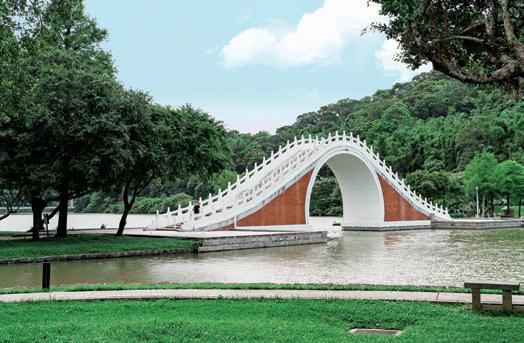
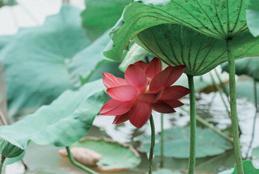
 Moon Bridge
Moon Bridge
Baishihu Suspension Bridge 29 A DAY IN TAIPEI
Dahu Park
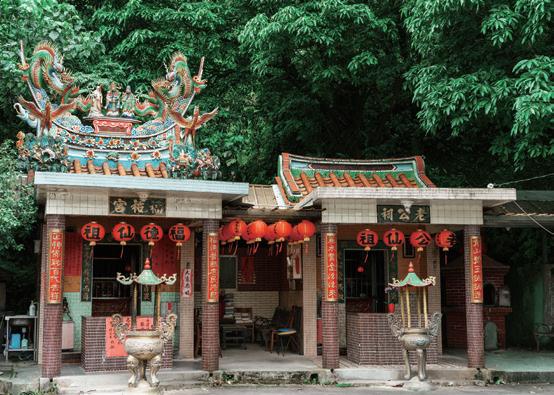

After spending some time in the park, next we go for an easy hike up the mountain on the south side of the lake. It takes about one hour to complete the well-maintained 1.85km trail.
According to the city government, over 60% of Neihu is covered in protected forest. Immediately south of Dahu is the low, tree-carpeted Bailusi (White Egret) Mountain, the most prominent feature of one of the district’s aforementioned spurs. This mighty “mountain” is a soaring 143m in altitude. It’s said its name comes from a colony of egrets that used to breed on the north side of the mountain during the Japanese era.
The Bailusi Mountain Trail has two trailheads, one on the mountain’s northwest side just off Dahu’s southeast corner, and the other on the southwest side, just off Jinhu Road. Both are clearly marked – the first with a large sculpture of a white egret mounted atop a post, the second with a boulder on which the trail name has been engraved in red-painted Chinese characters.
The route, paved and featuring night lighting, has flagstone and stone step sections. It is winding and twisting, especially on the north side, meandering through

pleasantly tranquil and shady tree cover. And it is narrow, with trees and shrubs for the most part very close. On the south side, along the bottom section, you’ll pass by small farm plots of fruit trees, and on the top section, just below the summit, you’ll pass a small clearing with a makeshift shelter where locals, mostly seniors, come to drink tea, exercise, and soak in the fresh air. There is a larger clearing at the summit itself.
While traversing the north side, from the summit and a limited number of openings in the tree cover you can peer down over Dahu at the mountain’s foot, and in the background, the elevated Taipei Metro line takes on the appearance of a serpentine white dragon circling the lake’s shore. On clear days the summit also affords a comparatively unobstructed sweep of true mountain giants to the north, most notably the iconic Wuzhi (Five Fingers) Mountain, five peaks protruding prominently along its ridge line.
 Two shrines near the Bailusi Mountain trailhead Fern seen along the trail
View of Neihu District from Bailusi Mountain
Two shrines near the Bailusi Mountain trailhead Fern seen along the trail
View of Neihu District from Bailusi Mountain
30 A DAY IN TAIPEI
The flagstone trail up Bailusi Mountain is easy to walk
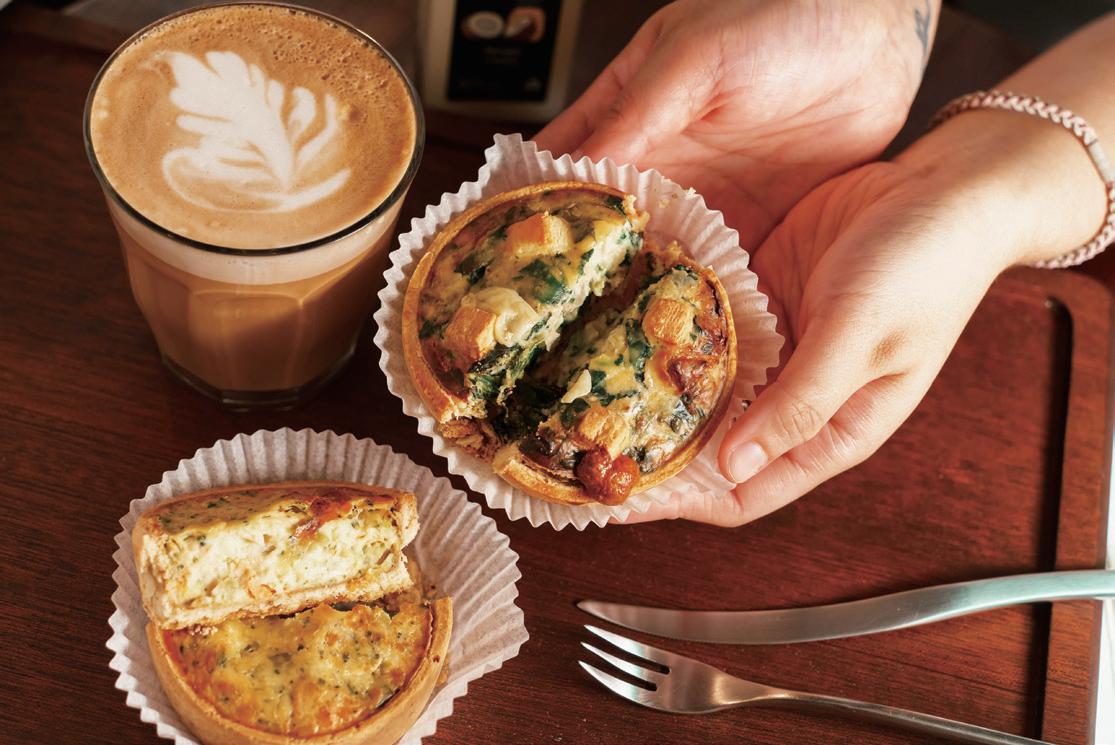
After reaching the southern trailhead, turn right and follow Jinhu Road north for about 1km to reach our next stop, a shop selling delicious French-style baked goodies.
The commercial area to the west of Dahu and Bailusi Mountain, within easy walking distance, abounds in good-tasting eateries and cafés. The urbane Gustave & Henri, a combination of bistro and patisserie, is the type of establishment you would serendipitously stroll by in a Paris quarter and find it impossible not to enter. The storefront is sleek subdued elegance, pitch black the primary design-theme color, with the mise-en-scène balanced with an exuberant painter’s palette of bright pastel color splashes – i.e., pictures of the feast of delectable French-style sweet and savory treats that awaits within, posted outside and just inside the entrance. Here is just a petit sampling of what is born in the Gustave & Henri ovens: the bestseller quiches, spinach and cheese and the sausage and tomato; tartes, the crème brûlée and salted caramel walnut; dacquoises, the mango, peanut, and signature praline. Bon appétit! GUSTAVE & HENRI

34, Jinhu Rd., Neihu Dist. (02) 8792-2953 10:00am-8:00pm www.gustavehenri.com
古斯塔·亨利
A DAY IN TAIPEI 31
Quiches are among the bestsellers at Gustave & Henri


Next, we head to MRT Neihu Station (5 min. on foot), not to take the metro, but to board a small bus that will take us to the district’s lush mountains.
Time now to head a ways up into the true mountains. Not far up-mountain from Dahu Park, reached via twisting Bishan Road, is Baishihu, a high-basin area rich with recreational farms (many organic), quality hiking trails, old temples, and lovely scenery. The trails, mostly flagstoned, lead you right through the farms – Baishihu is especially known for strawberry-picking operations.
The Baishihu Suspension Bridge is perhaps the area’s most recognized attraction. The charmingly photogenic 116m-long structure, which leaps a shallow stream valley, has a deliberate spinal cord “dragon bone” look to its design, emulating an auspicious dragon swooping across the landscape. It has a straight suspension design that is similar to that of an underspanned suspension bridge. Built and opened by the city government in 2010 to facilitate tourist foot-traffic access to the local leisure farms, it connects Bishan Road to the trail network wending through the farms on its north side.
Close along Bishan Road from the bridge entrance you’ll see the grandly ornate roadside arch that leads uphill to the magnificent multi-tier Bishan Temple. This slope-hugging complex does not look down into Baishihu; it’s on the Taipei Basin side of Zhongyong Mountain. It is both Taiwan’s largest and highest temple dedicated to Kaizhang Sheng Wang, literally the “Sacred King Who Developed Zhangzhou” – a Tang Dynasty general charged with developing Zhangzhou in China’s Fujian Province. Pioneer settlers who later crossed to Taiwan brought incense ash from home temples and raised new ones here.
Bishan Temple
©Department of Information and Tourism 32
Visiting Bishan Temple in the evening offers a unique experience with its beautiful night views
Bishan Temple began as the humblest of cave shrines in the early 1700s. This sacred spot still exists, in the temple’s rear. You’ll see three stones within; it’s said these were once one, split into three in the mid-1700s by lightning as a divine warning to make the local inhabitants look down and see that a force of attackers was gathering in the Taipei Basin below. The temple’s lofty perch serves up commanding views over the metropolis, especially intoxicating at sunset when the city lights come abloom.
Note that the temple is at the start/end of Section 5 of the Taipei Grand Trail (total trail length about 92km), a major city government initiative and a major draw for hiking enthusiasts.
The final stop on our Neihu excursion is a teahouse. From Bishan Temple’s car park, follow Bishan Road west for about 250m, turn right at the fork and you’ll shortly arrive at a quaint elegant teahouse.
To finish up your Baishihu walkabout, a bit of culinary refreshment is in order. Just upstream from the suspension bridge is the elegant Cook Cloud Tea House. Fronting the seating area, seen through a long wall of glass, is a serene garden courtyard with a carp-filled pond. The name “Cook Cloud” is embedded with the idea that while here you look up to savor the clouds above, and when looking down you savor the reflections of the clouds you’ve “cooked/ brewed” in your tea. Premium Taiwan leaf (with tea-brewing sets), coffees and other beverages, Taiwan-cuisine light meals, snacks, and Western-style desserts are on the menu, perfect for hikers to take a moment to unwind.

BISHAN TEMPLE 碧山巖 24, Bishan Rd., Neihu Dist. www.pkcswt.com.tw
COOK CLOUD TEA HOUSE 煮雲軒 31-1, Bishan Rd., Neihu Dist. (02) 2791-9636
Wed. to Sun. 11:00am-9:00pm instagram.com/cook_cloud
Bailusi Mountain Trail | 白鷺鷥山親山步道
Baishihu Suspension Bridge | 白石湖吊橋
Bishan Road | 碧山路
Dahu Park | 大湖公園
Moon Bridge | 錦帶橋
Jinhu Road | 金湖路
Wuzhi Mountain | 五指山
Zhongyong Mountain | 忠勇山


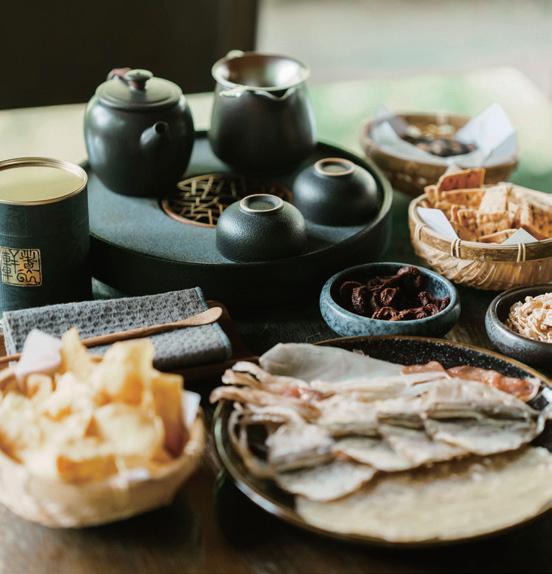 MAP Taipei Grand Trail
MAP Taipei Grand Trail
A DAY IN TAIPEI 33
At Cook Cloud Tea House, enjoy fine tea surrounded by nature
Stroll, Sip, and Savor the Views
How To Make The Most Of A Day Up In Maokong
TEXT | AMI BARNES PHOTOS | VISION
For Taipei-based hiking enthusiasts, it’s almost impossible to go wrong with a trip to Maokong. Convenient transport links and a hilly terrain converge to make the area an ideal quick getaway from the city center, while the local tea-growing heritage has blessed it with photogenic farmland and an abundance of teahouses – and cafés – ideal for rest and refueling.
Located on the slopes of Taipei’s Wenshan District in the city’s southeast corner, the most stylish way to reach Maokong is by the Maokong Gondola (www.gondola.taipei). The 25 min, 4km ride whisks you over a dense green canopy and through tendrils of low-lying clouds as your carriage soars towards the terminal stop, Maokong Station. Those who aren’t fond of heights can take a bus instead (the BR15 from MRT Taipei Zoo Station is the most frequent; this is also the starting point for the gondola run), and anyone with a surplus of energy can hike up from nearby National Chengchi University (NCCU) by following the Huanshan 2nd Road and Feilong (Flying Dragon) Trail.
Maokong’s hills are ribboned with hiking trails, which vary in difficulty from easy to “I’m-going-to-be-sore-tomorrow.” So, once you’ve picked your preferred mode of transport and have arrived, the next challenge is settling on a trail that suits the time of day and/or year, as well as your interests and/ or time constraints. In spring, cherry, peach, and apricot blossoms provide a visual treat in conjunction with short, easy strolls along the Camphor Tree Trail or around the grand grounds of Zhinan Temple. In wintertime, the sweetly perfumed Osmanthus Trail offers olfactory gratification. And year-round, you’ll find students burning the midnight oil with a quick postsunset jaunt up into the hills to watch the city lights blink and sparkle from roadside pavilions, cafés, or teahouses.
Those seeking a more vigorous challenge can set their sights on the Houshanyue or Mt. Erge trails – the first of which involves getting your hands dirty on an almost vertical fixed-rope climb – while longer walks into New Taipei City include a descent past the Yinhe (Galaxy) Cave waterfall, and a section of the Taipei Skyline Trail that traverses Bijia Ridge on its way to the streamside village of Shiding.
TEA AND BAMBOO SHOOTS IN MAOKONG
Wenshan District, home to the Maokong area, is well known for the cultivation of tea (especially Tieguanyin) and also bamboo shoots (Oldham bamboo). Maokong produces the most bamboo shoots in Taipei City, and its “golden-horn” bamboo shoots are being praised for their high quality. To highlight these two long-established agricultural sectors in the district, each year the Wenshan District Office organizes the Wenshan Tea and Bamboo Shoots Folk Culture Festival, which includes a wide range of activities, such as tea appreciation sessions, tea garden and bamboo grove DIY experiences, as well as a best bamboo shoot contest and a bamboo shoot banquet.
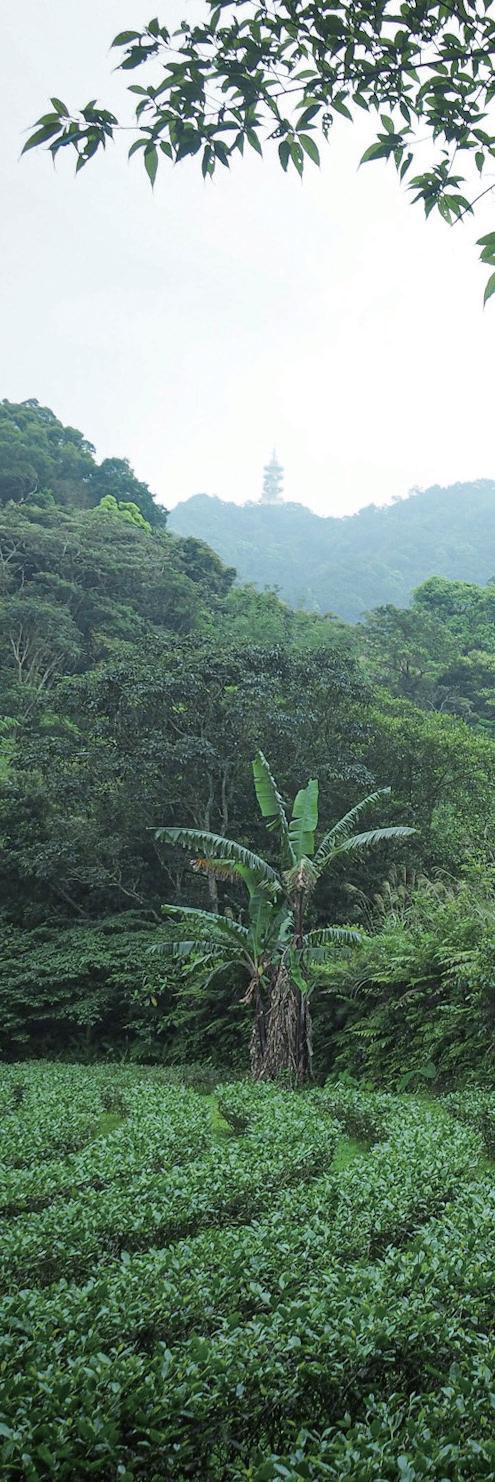
34 OUT IN NATURE

35 OUT IN NATURE
NCCU
Taipei Zoo Station
Tea Center Trail
Zhinan Temple
Camphor Tree Trail
Feilong Trail
Maokong Station
Pothole Trail
Lazy Day Cafe
Maokong Potholes Health Trail Mini Skywalk
Taipei Tea Promotion Center
The Health Trail starts opposite the Taipei Tea Promotion Center and leads down past tea plantations
Elsewhere Café

For adventurers who prefer their wanders on the easier end of the spectrum, turning left out of Maokong Station and following the main road (Section 3, Zhinan Road) will carry you to a trio of trails that can be completed without breaking too much of a sweat. Each can be walked independently or, alternatively, you can weave the three into a pleasant 3.5km loop that takes a couple of hours to complete.
First reached is the Health Trail, the entrance to which is located across from the Taipei Tea Promotion Center for Tie Guanyin Tea and Baozhong Tea . Steps zigzag down past tea terraces before diving into the shade of a wooded stream valley. This is the perfect habitat for the Taiwan Whistling Thrush, an endemic species that is often heard but seldom seen. These shadeloving, blue-feathered sprites flit from one shadowy nook to another, their piercing trill easily distinguishable above the calming gurgle of running water.
Following the stream’s course, you’ll soon arrive at a junction. Turning right here would result in a shorter, less effort-intensive walk, returning up toward Zhinan Road. However, if time and energy level permit, those who turn left will be rewarded for their exertion. This longer route descends on a raised wooden walkway through bamboo.
Small waterfall along the Tea Center Trail
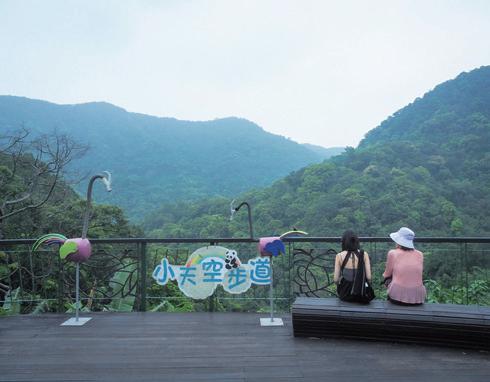
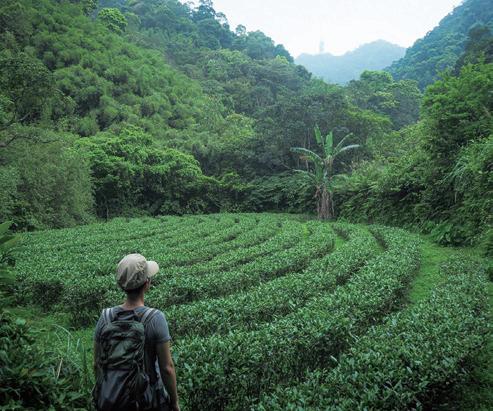
From the lower end of the Health Trail, near the Zhinan Stream valley’s bottom, it’s a short walk along a side road to pick up the start of the next path. This is the Tea Center Trail, and you’ll see signage indicating that this route will take you toward the Maokong Potholes. Climbing gently at first, the trail takes you past a waterfall – steps beside the path leading down to the foot of the falls for a better view.
The next section is the steepest ascent of the whole loop (you’re headed back up the side of the valley you just came down), but it’s mercifully short. After a 10-minute climb to the top of this section’s steps, a blink-and-you’llmiss-it side trail extends for 10 meters, terminating at a diminutive red and gold Land God shrine that houses a rock clad in godly regalia.
The walkway thereafter meanders through fields of bamboo, brightened by depictions of farmers tending to their crops, then at a crossroads, another side trail leads down

to the potholes. Surveying the streambed from a springy rope bridge, you’ll see circular depressions scoured out by a combination of eddying currents, waterborne gravel, and time. They are said to resemble scratch marks left by an oversized feline, and some claim them to be the origin of the name “Maokong,” which character-for-character could be translated to mean “cat hollow,” although others think the name refers to a valley once teeming with civets.
Heading back up to the previous junction, a left turn will put you on the Pothole Trail, which leads up through more tea terraces and a garden full of water irises until you arrive back on the main road. From there, hook a right, and you’ll soon find yourself walking along the Mini Skywalk. This last and easiest trail follows the road back to the Tea Promotion Center, offering occasional views of the distant city center along the way.
37 OUT IN NATURE
Pothole Rope Bridge near the Maokong Potholes
Lookout spot on the Mini Skywalk
One of many tea plantations in Maokong
In addition to gentle wanders, Maokong is best known for having a preponderance of teahouses and cafés, many of which stay open into the wee hours to allow guests to take in the night views as they sip on their beverage of choice.
One such haunt is the artsy Elsewhere Café - Night Owl Branch located about 250m northwest of the Tea Promotion Center. This establishment offers a small range of savory noodle dishes alongside a more extensive menu of coffees, teas, and cakes – making it ideal for a leisurely post-hike afternoon tea or coffee, or as its name suggests, a midnight getaway for the city’s night owls.

The overall atmosphere is one of an art student
common room. Cushions dot the comfy indoor seats, and there are sheltered outdoor areas suited to couples or small groups. Temporary art exhibits adorn the walls, a small store sells postcards and tote bags, and a row of shelves holds dogeared graphic novels for guests to take to their tables. Cats roam the premises, draping themselves over walkways and lounging beneath chairs, not caring a fig for all the comings and goings of their human coworkers or visitors. As night falls, strings of fairy lights come on to illuminate the leafy garden, and from the top-floor seating you can catch a glimpse of the city far below – just don’t get so comfortable that you miss the last gondola or bus ride down!


ELSEWHERE CAFÉ –NIGHT OWL BRANCH
8-5, Ln. 40, Sec. 3, Zhinan Rd., Wenshan Dist.
Thu. to Sun. 12:00pm-2:00am instagram.com/ elsewherecafe.mao
Where Elsewhere Café offers twinkling lights and resident felines, Lazy Day Cafe is all about hanging out in the embrace of Mother Nature. With not a socket in sight, it offers a break from the pressures of the everyday, and visitors who stray off the main road to descend its lamp-lined steps through thick tree cover will find a charmingly unpolished space that feels simultaneously cozily confined and at one with the surrounding greenery.
38 OUT IN NATURE
生活在他方-夜貓店
The café is managed by a husband and wife couple who preside over their little corner of calm with warm hospitality. The wife, in particular, enjoys welcoming guests from all corners of the globe and – when not preparing the homecooked cakes or dumplings – is on a mission to meet customers from every country (currently, she says the count stands at 60-something). And it’s not just the food that’s produced in-house. The husband is a lifelong Maokong resident from teafarming stock, so the Tieguanyin tea and honey used for their drinks are sourced from their plot of land.
Drink recommendations include the aforementioned Tieguanyin tea, which is naturally sweet with a slightly floral aftertaste and is served in a nifty teapot resembling a miniature stone rice mill. Other popular picks include the LazyDay blend coffee and osmanthus honey tea.


LAZY DAY CAFE 小日子
Ln. 38, Sec. 3, Zhinan Rd., Wenshan Dist. (about 250 meters southeast of Maokong Station) (02) 2301-7070
Tue. to Fri. 10:00am-7:00pm Sat. and Sun. 10:00am-8:00pm facebook.com/lazyday

MAOKONG TEA, TAIPEI ZOO, PUBLIC ART
If you are interested in learning more about Maokong’s tea production, visiting the Taipei Tea Promotion Center for Tie Guanyin Tea and Baozhong Tea is recommended. The center offers educational programs, guided tours, and tea-tasting sessions. It is open from 9am to 5pm (closed on Monday).
If thinking about combining a trip to Maokong with a visit to the Taipei Zoo, note that during July and August the zoo is open until 9pm on Saturdays, giving you more flexibility when planning your day.
An area rich in natural and agricultural resources, Maokong also has its share of cultural treasures. In the past two years public-art installations and performances have been presented as part of an ongoing cultural-brand project named Satoyama (www.satoyama-tpe.com). Last year for example, the celebrated Maokong-based performance troupe U-Theatre (www. utheatre.org.tw) gave a memorable performance at Zhinan Temple. The Satoyama events usually take place in November.

Camphor Tree Trail | 樟樹步道
Feilong Trail | 飛龍步道
Health Trail | 健康步道
Houshanyue | 猴山岳
Maokong Potholes | 貓空壺穴
Mini Skywalk | 小天空步道
Mt. Erge | 二格山
Osmanthus Trail | 桂花步道
Pothole Trail | 壺穴步道
Satoyama | 里山川
Taipei Skyline Trail | 台北天際線
Taiwan Whistling Thrush | 台灣紫嘯鶇 Tea Center Trail | 茶展中心步道
Taipei Tea Promotion Center for Tie Guanyin Tea and Baozhong Tea | 台北市鐵觀音包種茶研發推廣中心 U-Theatre | 優人神鼓 Wenshan Tea and Bamboo Shoots
Folk Culture Festival | 文山茶筍節
Zhinan Temple | 指南宮

39 OUT IN NATURE
MAP
Encounters with Extraordinary Wildlife in the City
At first glance, Taipei presents itself as a modern and vibrant city, densely populated, and seemingly devoid of natural habitats for wildlife. Yet, upon closer examination, the metropolis reveals its wilder side. Nighttime excursions, ideally accompanied by seasoned naturalists, are especially rewarding, offering glimpses of nocturnal denizens such as reptiles and amphibians.

Snakes
The Bamboo Pit Viper (Trimeresurus stejnegeri) is very common in the forests surrounding the Taipei core. You can distinguish it from the frequently misidentified Greater Green Snake (Ptyas major) by its rusty or red tail, triangular head, and white and/or red stripe along its flanks. Its green is also more of a matte green. While being venomous, this viper is typically non-aggressive in nature.
Chinese name: 赤尾青竹絲
Max. length: 90cm
Habitat: 0 to 1,500m above sea level
Status: least concern
Prey: frogs, small mammals, lizards, and birds
Note: This and several other snake species that may be encountered in Taipei are venomous. When hiking along minor trails, it is recommended to carry a walking stick to alert snakes that might be hiding in the grass or under fallen leaves.
TEXT & PHOTOS | RYAN HEVERN
National Park 40 OUT IN NATURE
Bamboo Pit Viper, seen near a creek in Yangmingshan


Frogs
The Taipei Tree Frog ( Zhangixalus taipeianus) is an endemic species found in the forests of northern and central Taiwan, typically inhabiting areas below 1,500m in elevation. Classified as vulnerable primarily due to habitat loss, this frog species favors breeding grounds in ponds and paddy fields, the latter of which are dwindling. Unlike other species that hibernate, the Taipei Tree Frog mates from October through April, often reproducing up to six times within a season. This is the time when you can hear its distinctive croak. It is the only frog species known to construct nests for its eggs. Despite its name, the Taipei Tree Frog predominantly resides in grass rather than trees. Another interesting fact is the frog’s remarkable ability to alter its skin color to blend seamlessly with its surroundings.
Chinese name: 台北樹蛙
Size: female 4.5-5.5cm, male 3.5-4.5cm
Habitat: from 0 to 1,500m above sea level subtropical or tropical moist lowland forest
Status: vulnerable
(www.ryanhevern.com), a Taipei-based wildlife
and outdoor enthusiast.
Photos shot by Ryan Hevern
photographer
near a pond in Fuyang Eco Park 41 OUT IN NATURE
Taipei Tree Frog, seen
Cooking with CookInn Taiwan
A DIY Dive into the Preparation of Three Local Food and Drink Classics
TEXT | MADISON JONES PHOTOS | POWEI CHEN
Despite its growing global appeal, Taiwanese cuisine and its cooking methods remain unfamiliar to many local and foreign food lovers. Whether it’s the unique ingredients, special equipment, or traditional techniques, those not privy to Taiwanese food culture tend to find these things obscure. Seeking to change this, one organization has taken up the task of spreading this island nation’s culinary knowledge: CookInn Taiwan. To gain firsthand insight, our writer, Madison, recently participated in one of the popular cooking classes offered by the group.

Located in the busy area north of Taipei Main Station, not far from Taipei Metro’s Zhongshan Station, CookInn Taiwan is a culinary organization that was founded for the purpose of imparting the joys of traditional Taiwanese cooking to the greater world. Currently, two types of activities are offered: cooking classes and team-building exercises. The sessions last around three hours on average. Among the cooking classes are choices focused on the traditional breakfast, xiaochi (Taiwanese snack foods), gourmet foods, and seasonal specials, such as zongzi (sticky-rice dumplings). Team-building classes
DIY FUN 42

include a cupcake challenge, a Taiwanese Oolong tea tasting class, and a xiaolongbao (small steamed buns) creation session. CookInn Taiwan is able to offer its program in English and Japanese as well as Chinese, and also prides itself on being able to accommodate patrons’ special requirements, including organizing child-friendly courses and sessions focused on vegetarian food.
Keen to find a better avenue to express and share her passion for traditional Taiwanese cuisine with domestic and foreign audiences, founder Chelsea Tsai established CookInn Taiwan in 2018. She has also written a book on the subject titled TASTE TAIWAN: Recipes from Taiwanese Home Kitchens . Initially starting with a modest space near National Dr. Sun Yat-sen Memorial Hall, the group has since expanded, increasing its staff and relocating operations to its current larger venue space, on the second floor of a high-rise commercial building.


 Rolling the xiaolongbao dough
Rolling the xiaolongbao dough
DIY FUN 43
Cooking class led by cheerful instructor Angela Wang

The CookInn Taiwan class I attended for this article, held on a Thursday morning, was led by cheerful and fun-loving instructor Angela Wang, who has been teaching cooking classes since the organization’s inception. What Angela enjoys most about her classes is the cultural exchanges she has with her students. “Every class has a different atmosphere,” she beamingly told me. Under her expert guidance, our small, multilingual group attempted to recreate three of Taiwan’s most ubiquitous classics: xiaolongbao, beef noodles, and bubble milk tea, along with a side of cucumber salad for good measure.
The bulk of our efforts were focused on the preparation of xiaolongbao from scratch. This involved EVERY step, from mixing the ingredients to rolling and kneading the dough, to mixing the filling of one-half ground pork and one-half gelatinized chicken stock. The most challenging part, however, was the final assembly. While holding a piece of dough with the four fingers of one hand, each of us rolled a small, drumsticklike rolling pin with the other to about halfway in one direction, stopped to turn the dough 15 degrees, and then repeated the process until it was fully flattened and reached a diameter of nine centimeters; an arduous process done to avoid creating creases or folds in the dough.
After placing exactly 26 grams of filling onto the dough, we had to cup the skin cautiously and use “lady fingers,” as Angela put it, to delicately pinch and rotate it while simultaneously pushing the filling down with our thumbs to maintain its bulbous shape. This process is certainly easier said than done, and extra dough had been kept on standby in case of mishaps. Thankfully, all participants were able to complete seven dumplings each without too much fuss. The overall experience gave me a newfound appreciation for the talented cooks at the famous Taipei dumpling restaurant Ding Tai Fung who make thousands of xiaolongbao every day, each dumpling made with exactly 18 folds, or so-called “Golden 18” as they refer to.


 Xiaolongbao
Cooking the beef noodle ingredients
Xiaolongbao
Cooking the beef noodle ingredients
DIY FUN 44
Finished beef noodle dish
Considerably less time was spent on the other creations. For the beef noodles, it was mostly a demonstration, as Angela invited a 10-year-old Taiwanese Australian boy to be hands-on alongside while his mother cheered him on enthusiastically from the sidelines, and rightfully so. The cucumber salad preparation was a brief demonstration by Angela on how to take out your daily frustrations on food: first place one of the ends of the cucumber on your forehead, and then proceed to smash the rest of it with the blunt of your knife! Assembling the bubble milk tea was also pretty straightforward – we simply combined all the ingredients using a cocktail shaker.
Overall, what I appreciated most about my CookInn Taiwan experience was not the amiable hospitality and not the tasty food treats, but the many cultural insights Angela shared with us. For example, we learned that the “bubble” in the name “bubble milk tea” does not in fact refer to the tapioca pearls or “boba” in the beverage, but rather the milk foam created from shaking the mixture until the liquid froths or “bubbles.” For this reason especially, CookInn Taiwan stands out as an exceptional place to learn more deeply about Taiwanese cuisine and culture.
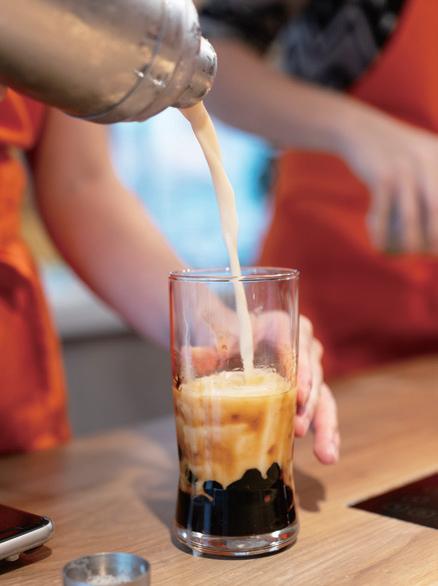
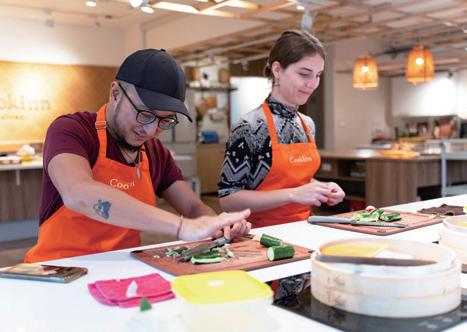

COOKINN TAIWAN
2F, 66, Sec. 1, Chengde Rd., Datong Dist. (02) 2517-1819 cookinn.tw/en
Chelsea Tsai | 蔡佩君 Ding Tai Fung | 鼎泰豐 National Dr. Sun Yat-sen Memorial Hall | 國父紀念館
 Chopping cucumber for the side dish
Bubble milk tea
Chopping cucumber for the side dish
Bubble milk tea
45 DIY FUN
Bubble milk tea ingredients
SAVORING TAIPEI’S SUMMER CUISINE
TEXT | JAMES BARON PHOTOS | VISION
From fruit tea stalls to shaved-ice outlets, Taipei offers myriad options for cooling
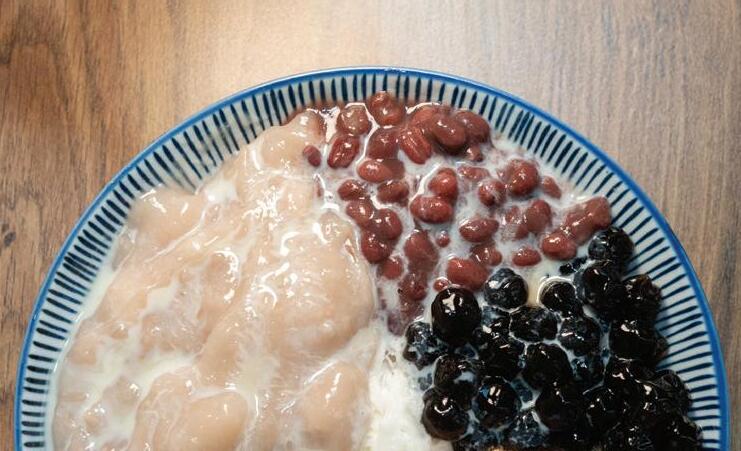
remain popular – especially when accompanied by a frosty beer. In this article, we introduce a few businesses that serve delicacies perfect for the summer season.

46 FINE FOOD
Frosty Treats
When looking for a sweet respite from Taipei’s hot and humid summer weather, look no further than eateries and roadside stalls selling traditional iced treats. Among the classics beloved by residents and visitors alike are tofu pudding, shaved ice, and snow ice – both served with a wide variety of toppings – and ice creations that incorporate Taiwan’s finest fruits.
Yu Nai Chuan

YU NAI CHUAN 芋艿川
15, Aly. 65, Ln. 71, Jiangnan St., Neihu Dist.
0976-826-529
12:00pm-9:00pm yunaichuan.com.tw
Branches of this tofu pudding provider have sprung up all over Taipei, and it’s easy to see why the brand has proved a hit. With its thatched roof-style parasols and bamboo furniture, the original store in Neihu District is an attractive and comfortable spot for a bowl of douhua (tofu pudding). The wooden tofu vats – one on the counter, from which spoons can be retrieved, and another larger one out front serving as a trash can – are a particularly appealing touch.
The two main offerings here are the regular douhua and another type served with a mountain of black sugar-infused shaved ice stacked on top. Both contain an assortment of sweetened beans, making what initially seems like a light snack surprisingly filling. During lunchtime, when office workers show up in droves, you might have to wait a few extra minutes for the iced variety, but it’s worth it. The combination of slushy ice and silkysmooth tofu works and is sure to please douhua aficionados.
Adjoining the serving area is a small store selling dried goods, oils, and snacks, all elegantly packaged and displayed. Branches of Yu Nai Chuan’s “tofu and grocery” stores can also be found at SKM Diamond Towers, at SKM Taipei Xinyi Place A8, and on Lishui Street, which neighbors Yongkang Street, well-known for its many restaurants and eateries. The newest location opened in May at Eslite Spectrum Nanxi.

FINE FOOD
47
Yu Nai Chuan douhua store in Neihu District

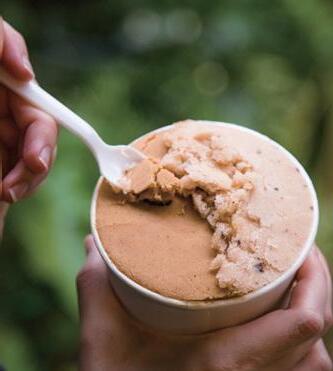
BEIMEN FENGLI ICE 北門鳳李冰
1F, 9, Aly. 33, Ln. 216, Sec. 4, Zhongxiao E. Rd., Daan Dist. (02) 2711-8862 12:00pm-9:30pm
Star Fruits Ice
Sour plums are a versatile treat in Taiwan: they are enjoyed as a candy, sprinkled on slices of fresh fruit in powdered form, and added to popular drinks such as kumquat lemon tea. The tart flavor of the prunes is achieved by preserving them for months in sugar and salt. It’s not just plums that can be preserved in this way; for two generations, the Zheng family has used a similar process to create a unique selection of icy treats featuring star fruit (carambola) at locations in Ximending , a popular shopping and entertainment district that is part of Wanhua District. After 56 years in a more central spot, the family was thought by many to have ceased operations in 2022 when that shop disappeared. However, regulars were thrilled to learn the business had just relocated to another spot, not far from the original outlet, at the intersection of Zhonghua Road and Emei Street
Introduced to Taiwan from Southeast Asia several hundred years ago, carambola gets its more common name from the stellar shape it takes when sliced in crosssection. While the fruit pieces in the bowls at this shop are cut lengthwise, they nonetheless absorb the icy liquid through their porous flesh, making each bite turgid and crunchy. In addition to the soup, there is also a carambola drink, which is slightly more watery and doesn’t contain fruit chunks. Pineapple options are also available.
Beimen Fengli Ice
Visitors to this unpretentious little enterprise might be somewhat confused by the name, as the premises are down a small lane in the East District, rather than the Beimen area (covered on the next page). The misleading nomenclature apparently comes from the owner’s background – she grew up in a neighborhood of Yilan City with the same name. There’s certainly no confusion about the products on offer: these are traditional, handmade ice of a type that was once more common in Taiwan before richer, milkier “Western-style” ice cream gained popularity. The signature item on the menu is perilla plum sorbet with either pineapple or lychee. The latter, for some reason, comes only in a size smaller than the former. There is also the option of a twoflavor combo featuring other choices, such as salty plum, taro, longan, peanut, and mung bean. While the pineapple and lychee ices contain dried-fruit pieces and have a delicate, refreshing taste, the peanut variety is thicker and sweeter. The items are available in small bowls or as popsicles – with mango and adzuki bean further options among the latter. Sweet bean and peanut soups and congees are also on the menu.

STAR FRUITS ICE 成都楊桃冰
144-1, Sec. 1, Zhonghua Rd., Wanhua Dist. (02) 2381-0309 12:00pm-10:30pm facebook.com/chenfu.
starfruitsice1966
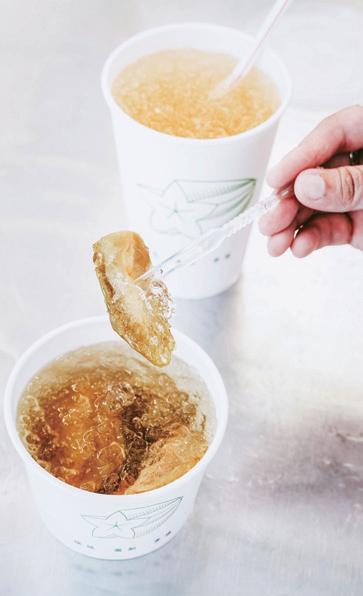
48 FINE FOOD

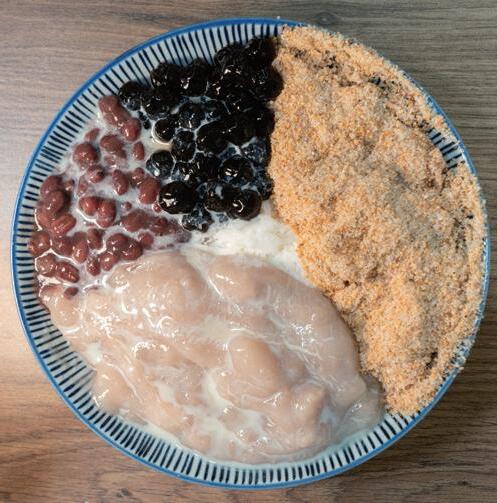
Mee t De sserts Meet Desserts
Another shop selling cool and sweet refreshments is Meet Desserts, located a short walk south from the North Gate (Beimen) along Yanping South Road. A standout here is the snow ice with taro and mochi, which comes with three extra toppings of your choice. These include aiyu jelly, grass jelly, and tapioca pearls. The pieces of mochi, which are snipped with scissors and coated with peanuts, have what the Taiwanese describe as a “Q” texture (roughly akin to “chewy”), which perfectly complements the mixture of gloopy taro sauce and milky ice flakes. For something really special, try the shaved ice with sesame tangyuan (glutinous-rice balls) and osmanthus syrup. “Eat it quickly,” says Mr. Huang, who runs the shop with his wife. He’s right. One bite of the hot globules releases oozing sesame paste, creating a pleasant
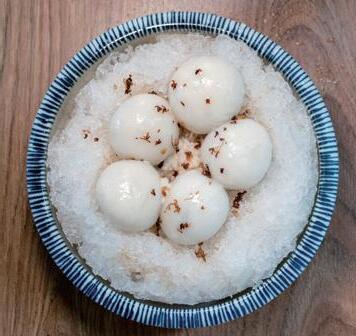
MEET DESSERTS 來呷甜甜品
11, Yanping S. Rd.,Zhongzheng Dist. (02) 5596-4288 1:00pm-8:30pm instagram.com/meetdesserts
contrast with the ice. A minuscule amount of alcohol from weakly fermented grain is used in the syrup – just enough to impart a subtle aftertaste and create a slight bitterness with the sesame.
The North Gate area, located west of Taipei Main Station, is full of historical landmarks. Close to the gate itself – one of the few surviving remnants of Taipei’s old city walls – is the Taipei Post Office. Completed in 1930 during the 1895~1945 period of Japanese rule of Taiwan, this imposing structure features Baroque motifs, a colonnaded portico, and a small postal museum. Nearby is another attractive relic from the Japanese era – the Futai Street Mansion, built in 1910, originally an office facility for a Japanese construction firm.
49 FINE FOOD
Fiery Fries
Stir-fry restaurants in Taipei offer a glimpse into the city’s vibrant street food culture. These restaurants are often simple affairs with a lively atmosphere where patrons sit on low stools and order from menus with a large number of seafood, meat dishes, and vegetable offerings. There is no shortage of beer to wash it all down.
Gandou
Few experiences convey the exuberance of Taiwanese dining culture like a crowded stir-fry restaurant, and they don’t get much more packed than the flagship location of Gandou on Minsheng East Road. By 7pm, the second-floor restaurant is heaving; yet orders, which are taken via a touchscreen, arrive at breakneck pace.
The restaurant emphasizes its use of Cantonese culinary techniques acquired by patriarch Hsu Tian-sheng, who got his start as a kitchen hand at a Guangzhou-style establishment and eventually worked his way up to stir-fry master status. Having opened his first restaurant in 1987, Hsu kicked off the Gandou franchise with his first branch in New Taipei City more than a decade ago. The name, which translates roughly as “port capital,” has its origins in Hsu’s reminiscences about his military service in the southern port city of Kaohsiung. Note, however, that for considerations of freshness, the restaurant’s seafood ingredients are sourced from the northern port city of Keelung.
The tofu with crab butter and the broiled fish chin are two excellent choices for those looking for something a little less run-ofthe-mill. The former contains succulent bean cubes and pieces of crab in a glutinous sauce; expert grilling leaves the skin of the latter crispy and the flesh juicy. And, despite the maritime theme, there’s far more than fish to tempt you. Classics such as beef with scallions are found alongside intriguing items such as stir-fried intestine with string bean. Unlike most dishes featuring internal organs, the innards are crispy and covered in crunchy shallot flakes.

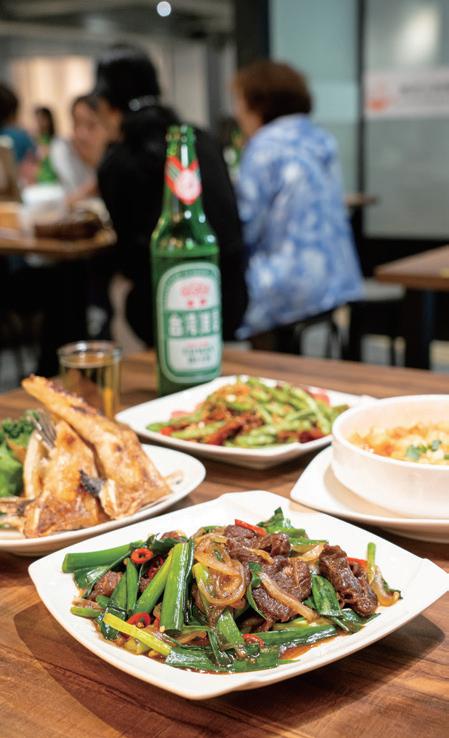

52, Sec. 1, Minsheng E. Rd., Zhongshan Dist. (02) 2522-1918
5:00pm-1:00am gandou.com.tw


50 FINE FOOD
GANDOU 港都熱炒
Broiled fish chin
Tofu with crab butter
Stir-fried intestines with string bean
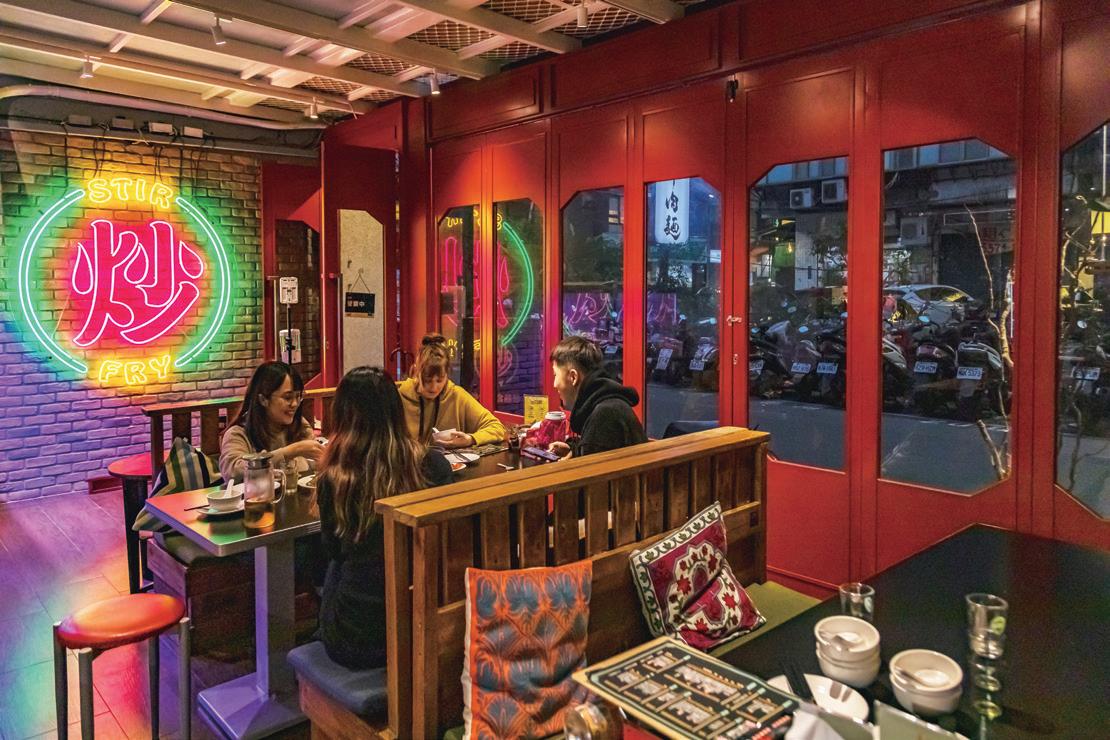
Chao Stir Fry
“How does it taste?” the waiter asks, as we tuck into the Kung Pao chicken. “Delicious,” is the answer. But it’s the texture, more than the flavor, that one first notices when nibbling on these golden nuggets. As with all the dishes at Chao Stir Fry, a superb vegan eatery, the “meat” in this Sichuanese classic is fashioned from plantbased substitutes. Seasoned gourmands are unlikely to mistake the poultry replacement for the real thing, but the combination of crispy flour coating and tender interior makes for a unique mouthfeel.
That’s not to underplay the taste experience at this restaurant. The sweet and sour “fish” is delightfully tangy, and nicely offset by slices of zesty bell pepper, and the unconventional serving of stinky tofu as a mash accentuates the pungency of the nightmarket staple. The string beans are cooked to crunchy perfection, and – nestled between them – is the most convincing meat substitute. This is Omnipork, fashioned from non-GMO soy, shiitake mushroom, pea, and rice.
The top-notch fare at Chao Stir Fry is enhanced by a convivial eating environment – somewhere between traditional stir-fry hubbub and bistro chic. As you enter from the small lane it sits along, an eyecatching neon sign greets you at the entrance. It features the single Chinese character for the restaurant’s name, 炒 (chao, meaning “stirfry”) – executed with a panache that bespeaks marketing flare. In keeping with the animal-friendly environment, the fish tank is also vegan, featuring nothing but bath toys! Orders are taken by QR code and arrive promptly. Your food can be washed down with Taiwan Beer 18 Days Draft – an unpasteurized lager with a shorter shelf life and smoother taste than its other offerings.
CHAO STIR FRY 炒炒新亞洲蔬食
21, Ln. 52, Sec. 1, Daan Rd., Daan Dist. (02) 2775-3005
Mon. to Fri. 5:00pm-11:00pm Sat. and Sun. 11:30am-2:30pm, 5:00pm-11:00pm instagram.com/chao_stir_fry


Please drink responsibly
51
Tu Jiao Cuo
Often easily identifiable by their turquoise wooden door frames and trimming, several notable military dependents’ village restaurants can be found in Taipei. Originally established by the families of Nationalist soldiers who arrived in Taiwan from mainland China post-WWII, these places feature old Chinathemed memorabilia and an array of retro ornaments.
Located roughly midway between Taipei Metro’s Wanlong and Jingmei stations, Tu Jiao Cuo restaurant is worth visiting just for the décor. Record covers and movie posters featuring stars of yesteryear adorn the main wall of the interior dining space, while a display cabinet of cartoon and comic book collectible toys stands before the wall opposite. In one corner there’s a vintage television set, in another a dusty poster covered in paper slips that way back when could be removed like an Advent calendar to afford patrons a chance to win bottles of Taiwan Beer or packets of Long Life cigarettes. On the back wall, above a blackboard, the requisite portrait of father-of-the-nation Sun Yat-sen appears in the middle of the Chinese characters for one of his famous slogans: tian xia wei gong (the world is for all people).
A must-try dish here is the “matsusaka” pineapple pork. Rather than denoting Japanese origin, the name is used in Taiwan to describe cuts with a desirable fat-to-meat ratio. The lightly seasoned slices are served with pineapple on a bed of red

Emei Street | 峨嵋街
Futai Street Mansion | 撫台街洋樓
Hsu Tian-sheng | 許天生
Lishui Street | 麗水街
Minsheng East Road | 民生東路
North Gate | 北門
Taipei Post Office | 台北郵局
Ximending | 西門町
Yangping South Road | 延平南路
Yongkang Street | 永康街
Zhonghua Road | 中華路

onions, cucumber wedges, and cherry tomatoes, with a garnishing of cilantro topping things off. A vinegar dressing completes a wonderful blend of flavors. Another tasty and healthful option is the shuilian, known in English by the evocative names crested floating heart and white water snowflake. The small olive-like items amid the steaming strands are the pickled, immature fruits of the cordia dichotoma – or Indian cherry tree. Seafood delicacies include the salty, grilled prawns and crispy, deep-fried icefish.
In addition to enjoying iced treats and savoring stir-fried dishes accompanied by cold beer, Taipei’s hot summers also beckon you to try other refreshing remedies. From freshly pressed fruit juices to traditional herbal teas – well known for their cooling properties – and cold noodles, there is no shortage of revitalizing options in the city.

Crispy deep-fried burdock
Dist.

52 FINE FOOD
MAP
TU JIAO CUO 土角厝懷舊小吃店 2-1, Sanfu St., Wenshan


53 FINE FOOD
"Matsusaka" pineapple pork
Where to Work Out
Taipei’s Modern Sports Centers
For many people, a healthy lifestyle includes regular workouts and engaging in sports activities. Taipei is a city of many parks and bikeways, and the great outdoors in the form of verdant mountains with a network of great hiking trails is just a short drive or bus ride away. For those who prefer working up a sweat indoors or are looking for facilities on bad-weather days, the city has numerous excellent sports centers as well.
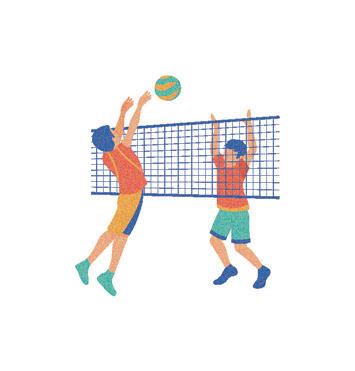



Each of Taipei City’s 12 districts has at least one sports center administered by the municipal Department of Sports. These centers, featuring a wide range of facilities, are open to the public and can be used by both residents and visitors to the city without the need to apply for any membership.
While the centers might have various facilities in common (gym, dance rooms, swimming pools, etc.), some of them are equipped with unique facilities for more unusual sports as well, allowing you to find a center to your liking for almost any indoor sport.
If swimming and/or diving is your thing, head to the Song Shan Sports Center, which has large swimming pools (50m/25m). Free-diving is possible at certain times of the day in special areas, and you can sign up for free-diving classes. Swimming, springboard diving, kayaking, and water polo classes are available as well.
Over its 10 floors, the Shilin Sports Center has a marvelously wide range of options, the most interesting of which are the climbing wall (5th floor) and the small-sized soccer field (top floor; artificial turf).
Want to test your skill with a bow and arrow? Head to the Jhong Jheng Sports Center ! On the 9th floor of the center is a 30m shooting range with 12 lanes. On other floors, you’ll find spaces for badminton, table tennis, and snooker (incl. foot snooker). In the basement is a 50m swimming pool.
The Beitou Sports Center comes in handy if you want to jog indoors, but not on a treadmill. On the center’s 3rd floor is a 110m track, circling the basketball court (in view) on the floor below. Also on the same floor is a squash court, and in the basement you’ll find a 50m swimming pool.
Nan Gang Sports Center has a rock-climbing wall (beside the 3F basketball court) and a 30m archery range on its top floor (8 lanes). The most unusual facility of the center, however, is the air pistol shooting range on the 5th floor.
Finally, you can go inline skating indoors in the Da-Tong Sports Center ! The international-standard 50×25m skating rink is used for both skating and inline hockey.
For an overview of all centers, visit the venue booking site:



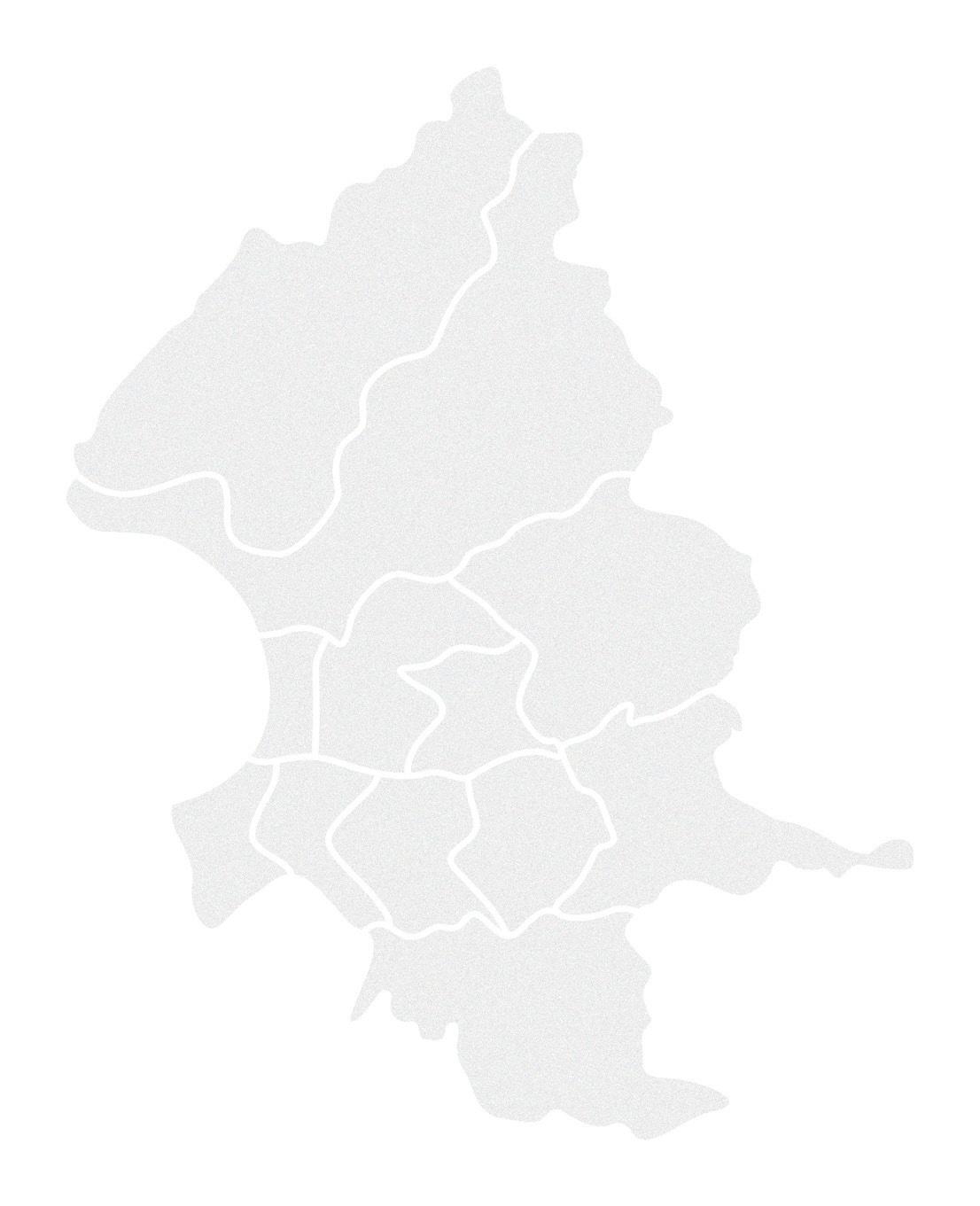
TEXT | TWELLI ILLUSTRATION | VISION 54 WHERE TO…








1 2 3 4 5 6








DA-TONG SPORTS CENTER 大同運動中心 51, Dalong St., Datong Dist. (02) 2592-0055 dtsc-wdyg.com.tw/english Minquan W. Rd. Station 1 2 3 4 5 6


SONG SHAN SPORTS CENTER 松山運動中心 1, Dunhua N. Rd., Songshan Dist. (02) 7755-5058 sssc.com.tw
Taipei Arena Station
SHILIN SPORTS CENTER 士林運動中心 1, Shishang Rd., Shilin Dist. (02) 2880-6066 slsc-taipei.org/EN
Shilin Station
JHONG JHENG SPORTS CENTER 中正運動中心 1, Sec.1, Xinyi Rd., Zhongzheng Dist. (02) 2880-6066 tpejjsports.com.tw/zh-TW/english
Chiang Kai-Shek Memorial Hall Station
BEITOU SPORTS CENTER 北投運動中心 100, Lane 39, Sec. 1, Shipai Rd., Beitou Dist. (02) 2820-2880 btsport.org.tw
Shipai Station
NAN GANG SPORTS CENTER 南港運動中心 69, Yucheng St., Nangang Dist. (02) 2653-2279 ngsc.cyc.org.tw
Houshanpi Station
2025 World Masters Games
Next year will be another important sports year for Taipei. After successfully hosting the Deaflympics in 2009 and the Summer Universiade in 2017, Taipei City will again, this time together with New Taipei City, host a major sports event, the World Masters Games. What makes these games special – and different from professional sports events like the Olympic Games – is that anyone can register to participate (there are minixmum age restrictions and limited slots, however). Around 30,000 athletes from across the world, competing individually and not as part of national teams, are expected to compete in 35 different sports. For more information about the World Masters Games, check out the official website.

This year there will be a series of warm-up events. If you are interested in taking part in these events, you can register until the maximum number of participants has been reached.


Official Website Warm-up Events 55 WHERE TO…
TRAVEL INFO
Service Hours: 6:00am - 12:00 midnight Customer Service Hotline: (02)218-12345 METRO
METRO
TAIPEI
TICKETS


ONE-WAY TRIP TICKET
- NT$65


EasyCard (left) and iPASS (right) are available at MRT stations and convenience stores. Just add value before entering the system; the fare for each journey will be deducted appropriately. These cards also have an e-purse function for use at convenience stores and other authorized businesses, and for YouBike rentals. IC CARDS
TAIPEI CITY BUS
TICKET PRICE
Adult: NT$15, regardless of using cash or an EasyCard Student: NT$15 when paying cash; NT$12 when using an EasyCard (Student ID required) Child under 115cm or under six years old: Free (ID required)
YOUBIKE







Taipei eBus ebus.gov.taipei FOR MORE INFORMATION
YouBike is Taipei’s public rental bike system. To rent a bike, you can use an EasyCard or a credit card. The charge per 30 minutes is listed below.
Within 30 minutes 30 minutes to 4 hours
NT$0 with member-only subsidy
NT$10 per 30 minutes
To register as a member, please check youbike.com.tw/region/taipei/register/
TAIPEI FUN PASS
There are four types of Taipei Fun Pass available: the Unlimited version (attractions+transportation), the Exploring version (attractions +EasyCard), the Classic version (2 attractions+EasyCard) and Transportation version (transportation only). You can visit Taipei City, New Taipei City, Keelung City, and Taoyuan City within the validity.

Unlimited 1 Day Pass/ 2 Day Pass/ 3 Day Pass
NT$1,200/1,600/1,900
TRAVEL INFORMATION SERVICES
Tourism Administration, Ministry of Transportation and Communication: Information for Foreigners in Taiwan: 1990
Taipei Citizen Hotline: 1999 (Outside Taipei City, please dial 02-2720-8889)
Taipei Travel Net: travel.taipei/en; presents travel information on Taipei City in Chinese, English, Japanese, Korean, Thai, Indonesian, Vietnamese, and Spanish

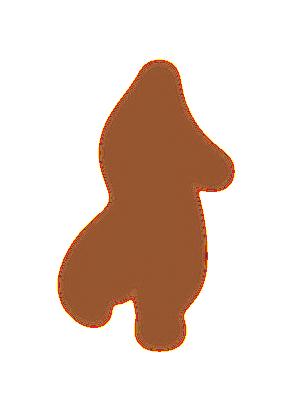




NT$20
24HR PASS NT$180 DAY PASS NT$150 48HR PASS NT$280 72HR PASS NT$380
EasyCard iPASS
























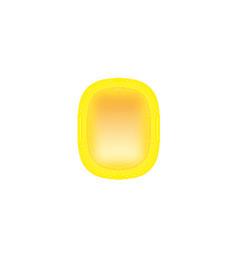










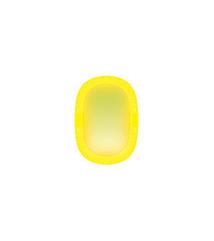






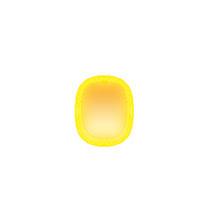


























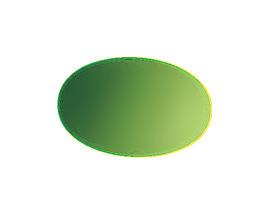






















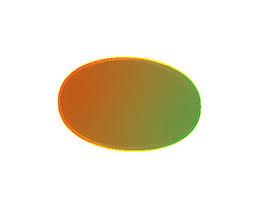
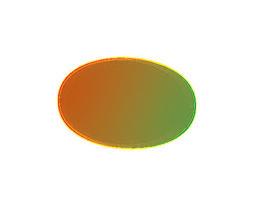





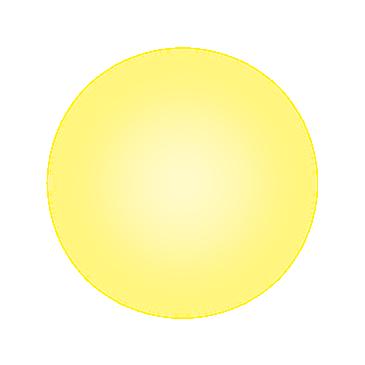








AD

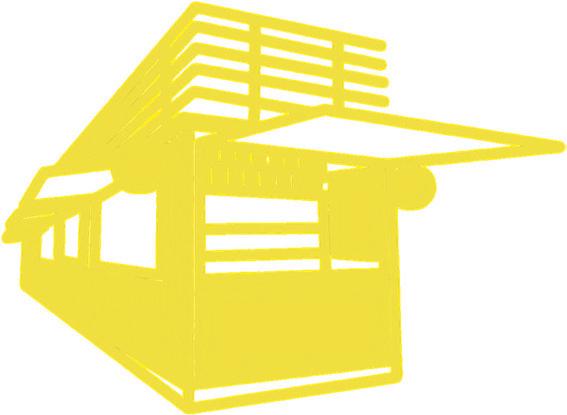












AD



 SUMMER 2024 NO.36
SUMMER 2024 NO.36


















 Songshan Ciyou Temple Specialties from the indigenous Paiwan and Amis peoples
Songshan Ciyou Temple Specialties from the indigenous Paiwan and Amis peoples

 Old cassette tapes on display in the Cultural Cube
Old cassette tapes on display in the Cultural Cube




 Kafka by TMC has a small stage for live music performances
Kafka by TMC has a small stage for live music performances




 MAP
Both hard and soft drinks can be enjoyed in the W9T Area
Please drink responsibly
MAP
Both hard and soft drinks can be enjoyed in the W9T Area
Please drink responsibly








































 A few doors from the antique shop, we then arrive at our final stop for the day, a restaurant serving excellent Western
A few doors from the antique shop, we then arrive at our final stop for the day, a restaurant serving excellent Western




 Moon Bridge
Moon Bridge



 Two shrines near the Bailusi Mountain trailhead Fern seen along the trail
View of Neihu District from Bailusi Mountain
Two shrines near the Bailusi Mountain trailhead Fern seen along the trail
View of Neihu District from Bailusi Mountain







 MAP Taipei Grand Trail
MAP Taipei Grand Trail





















 Rolling the xiaolongbao dough
Rolling the xiaolongbao dough



 Xiaolongbao
Cooking the beef noodle ingredients
Xiaolongbao
Cooking the beef noodle ingredients



 Chopping cucumber for the side dish
Bubble milk tea
Chopping cucumber for the side dish
Bubble milk tea





































































































































































